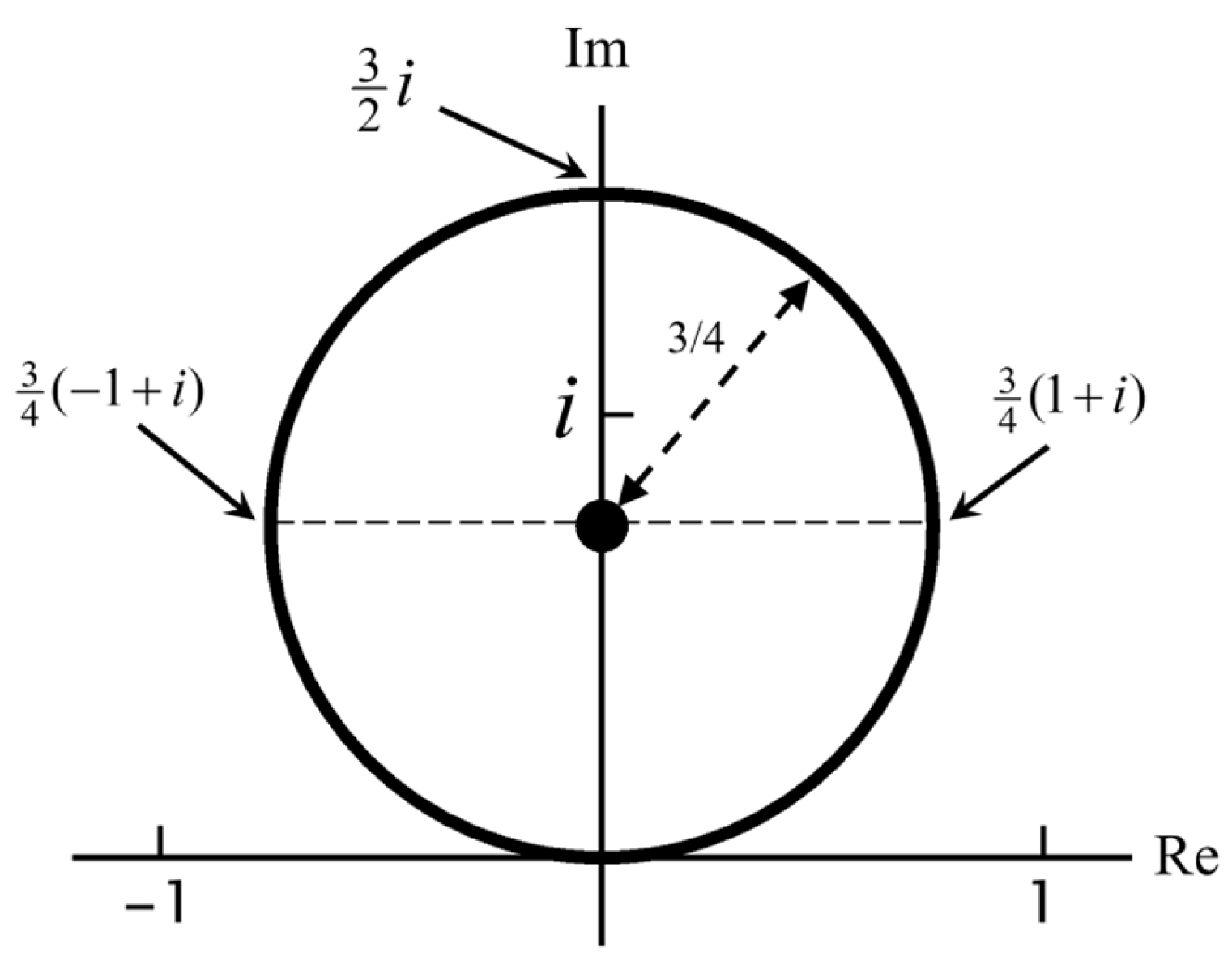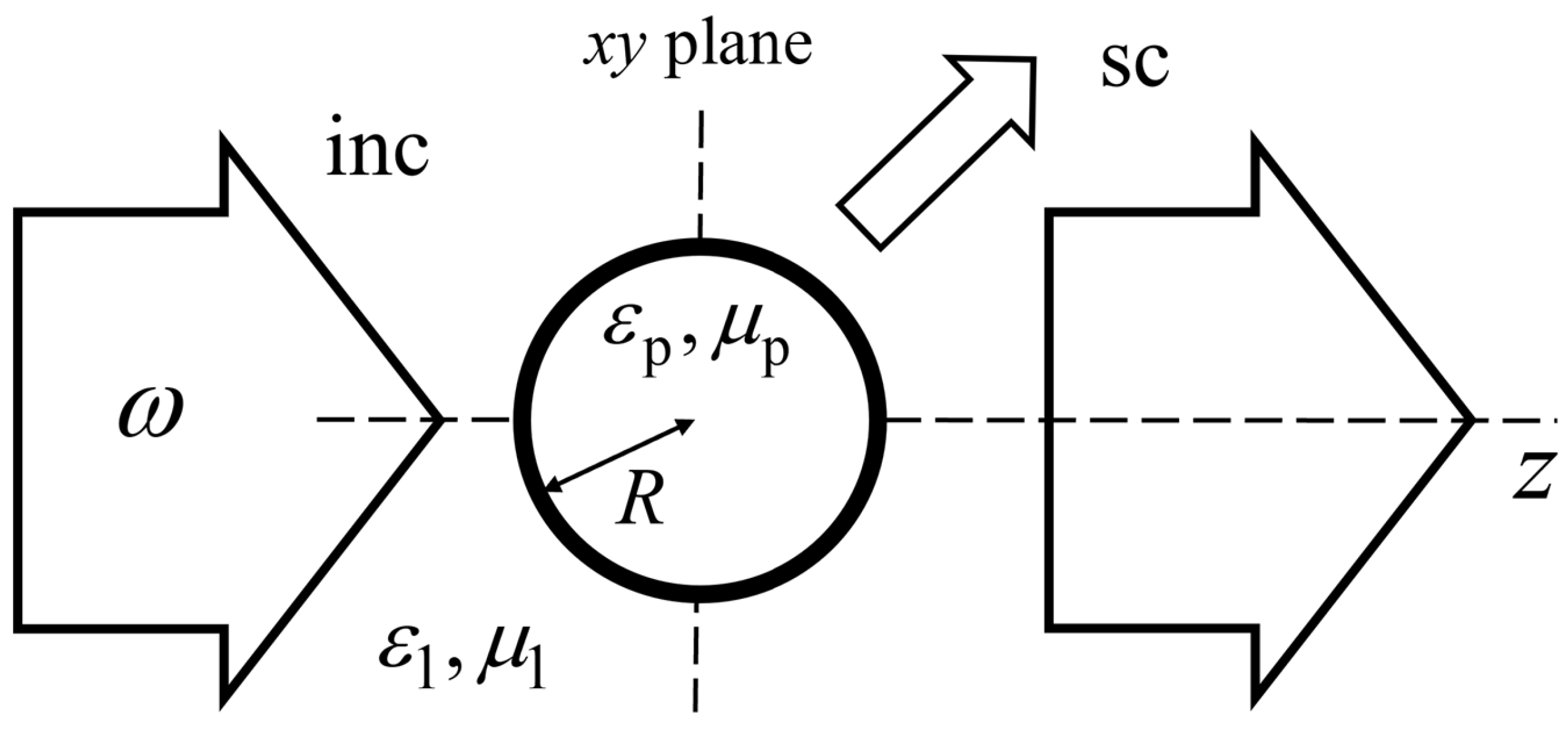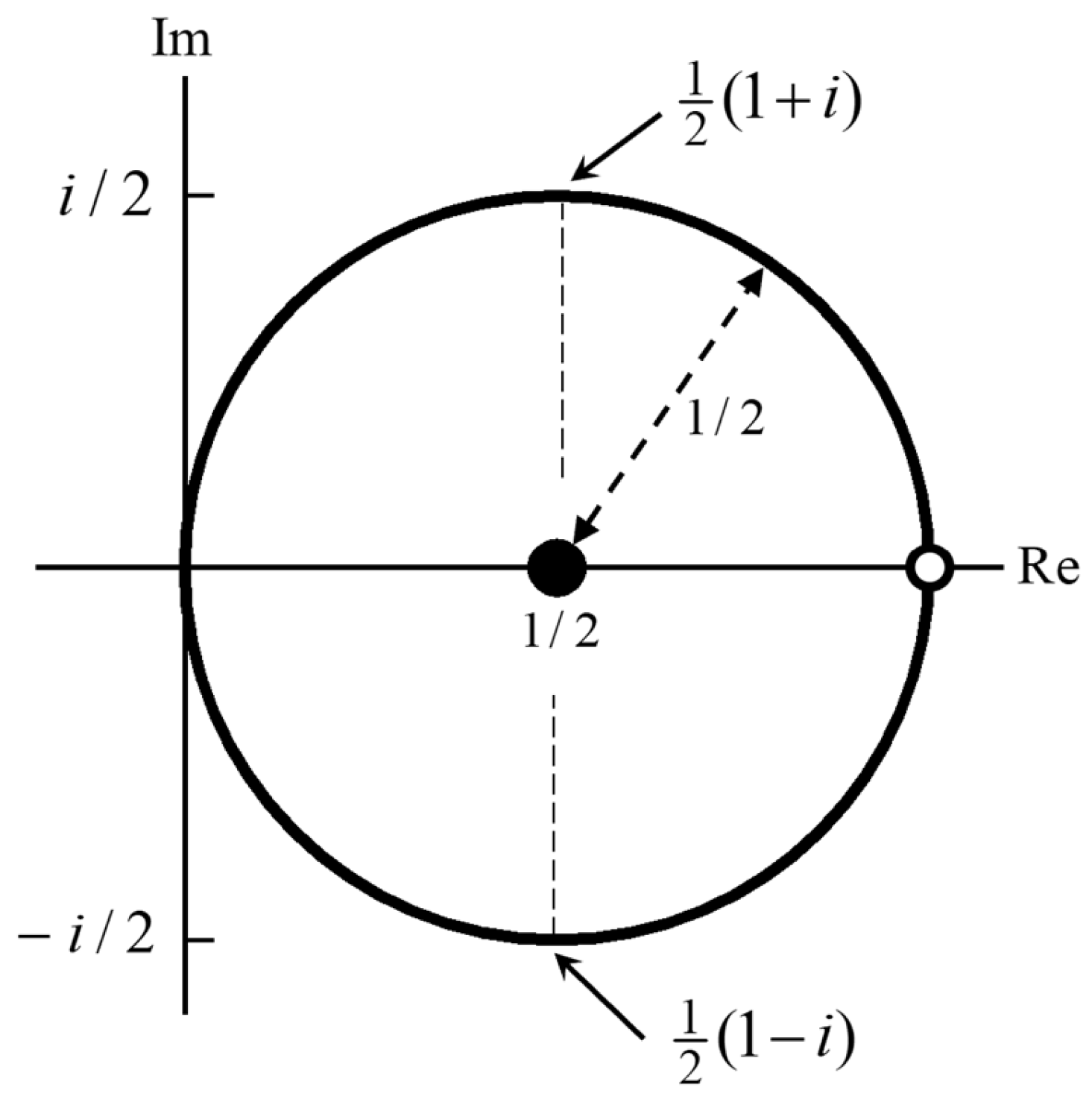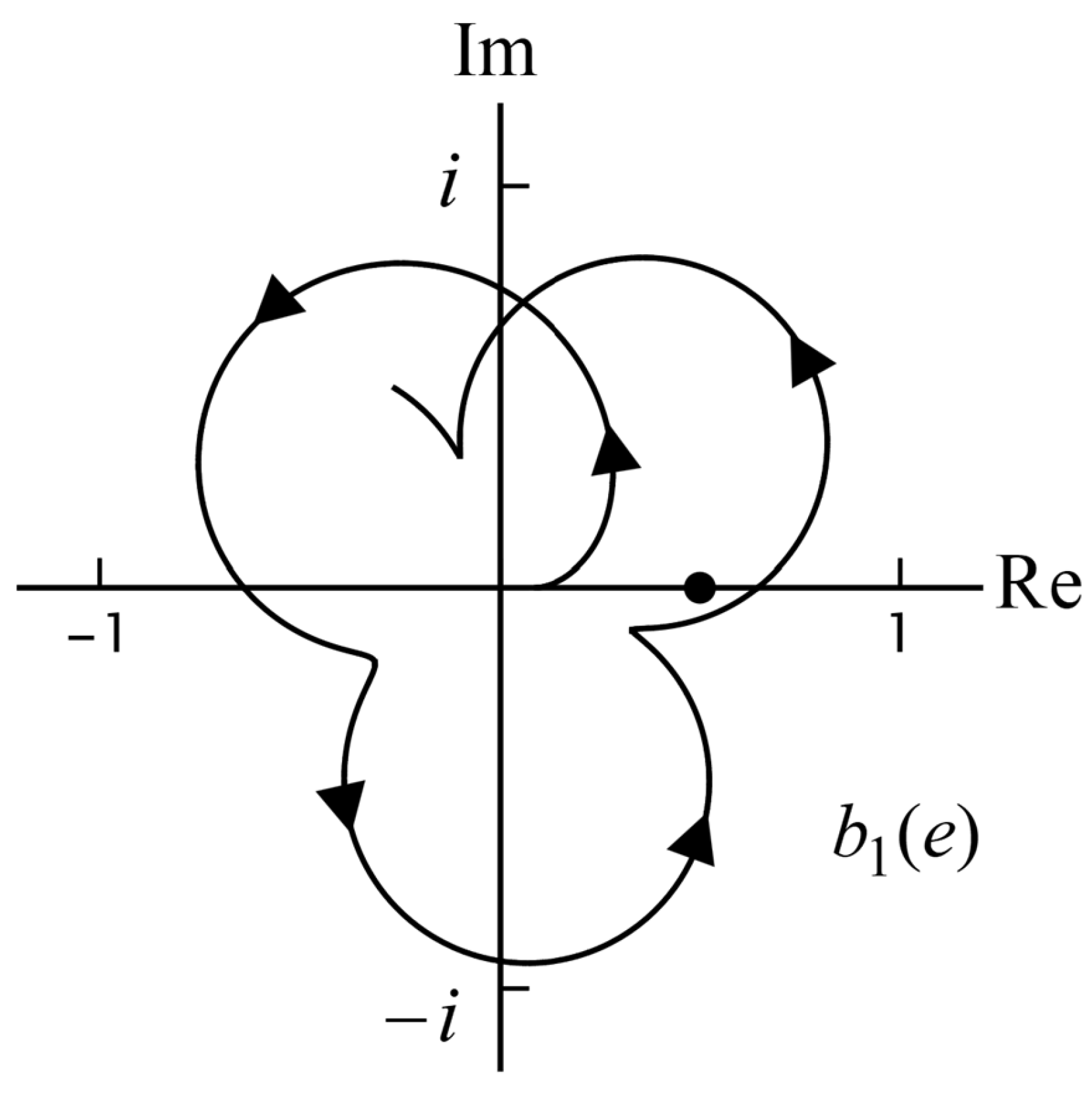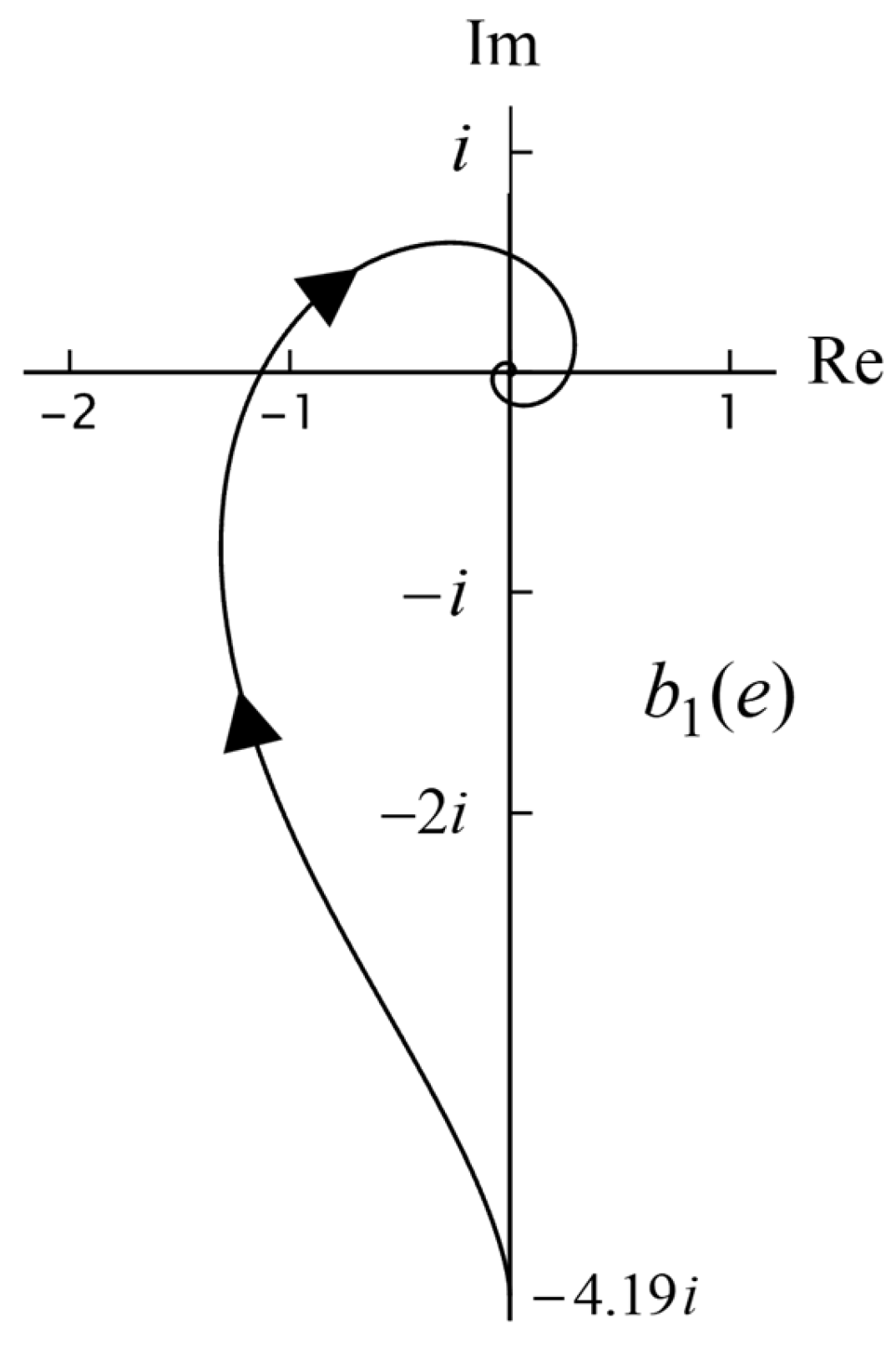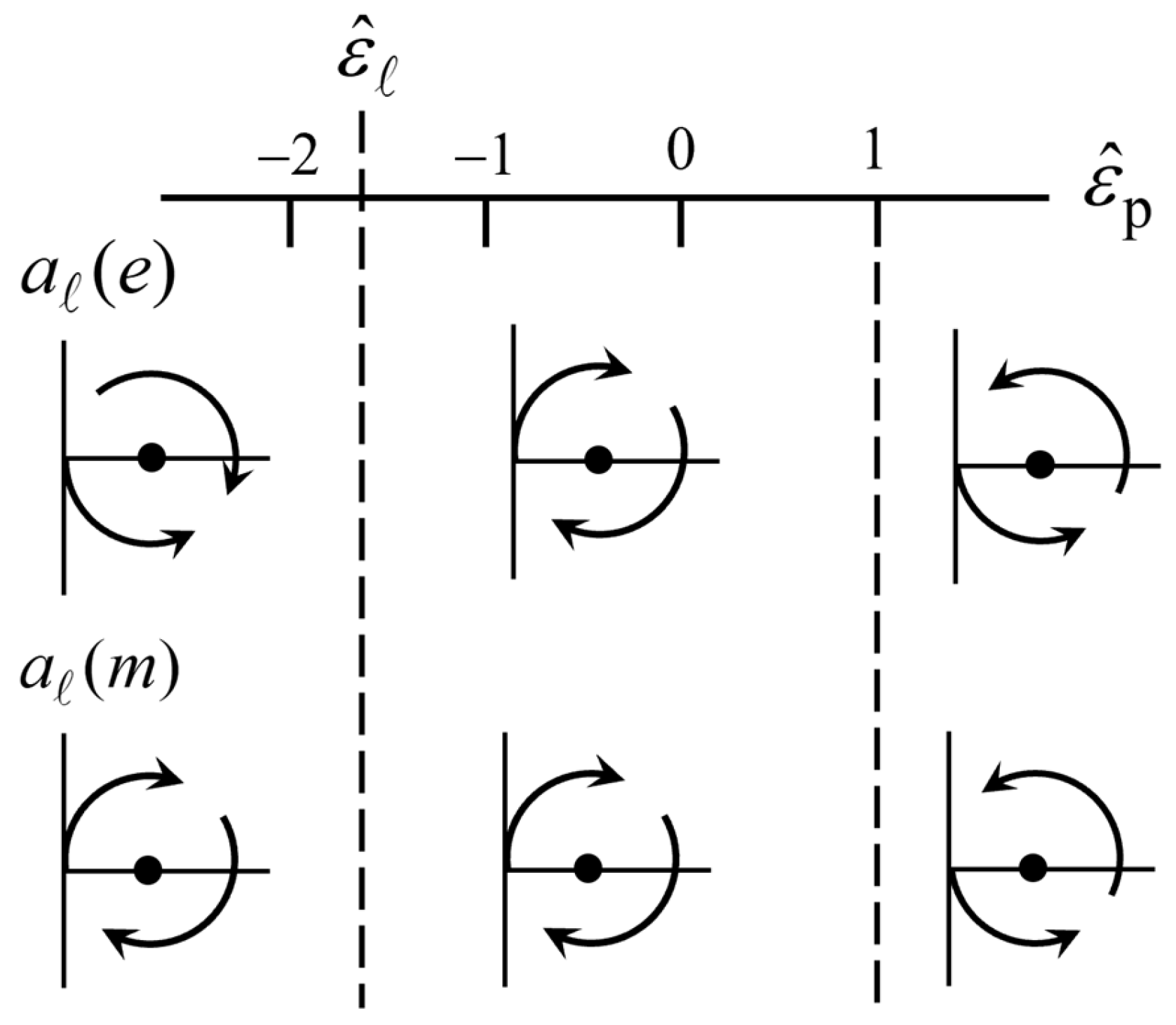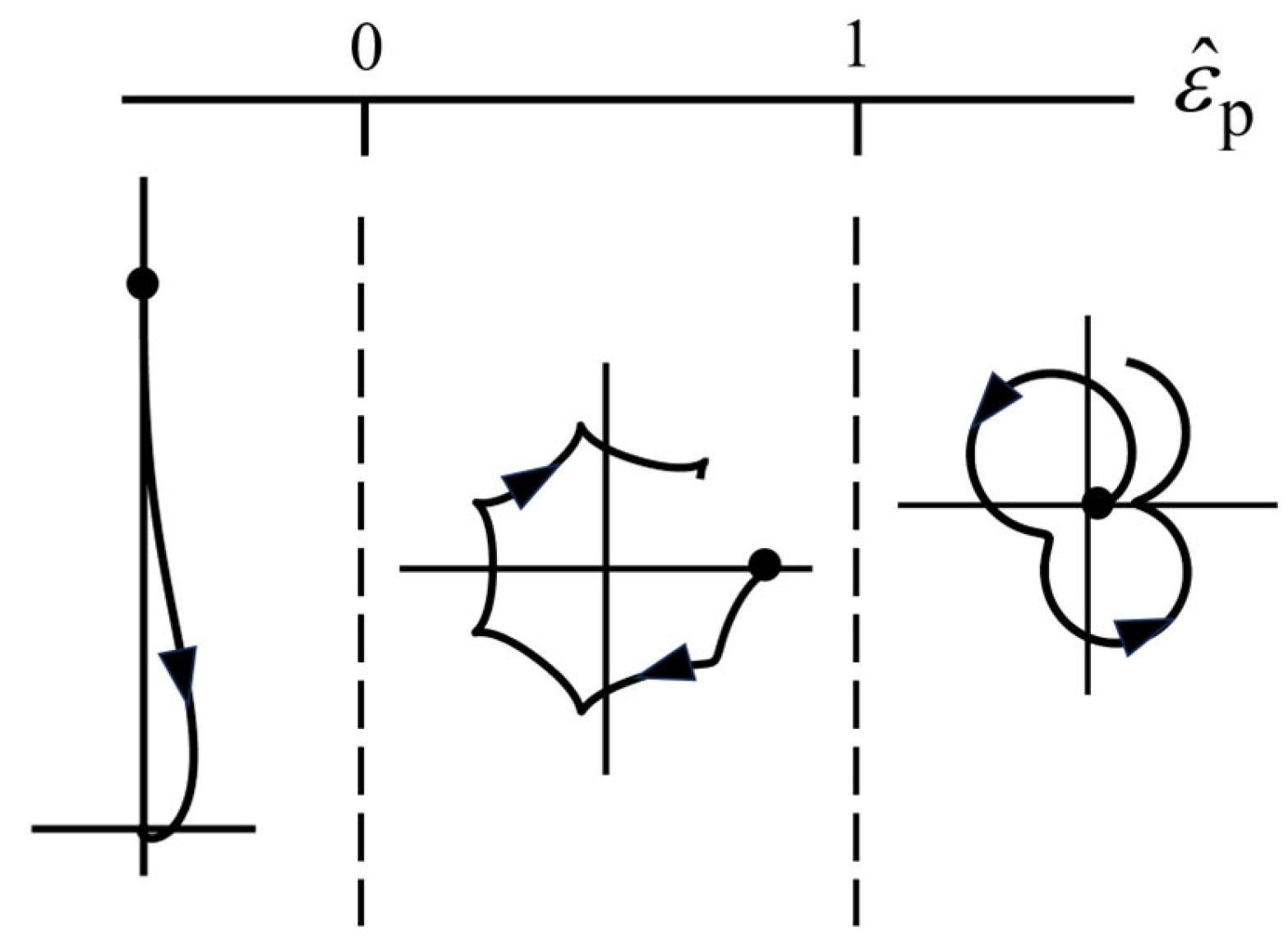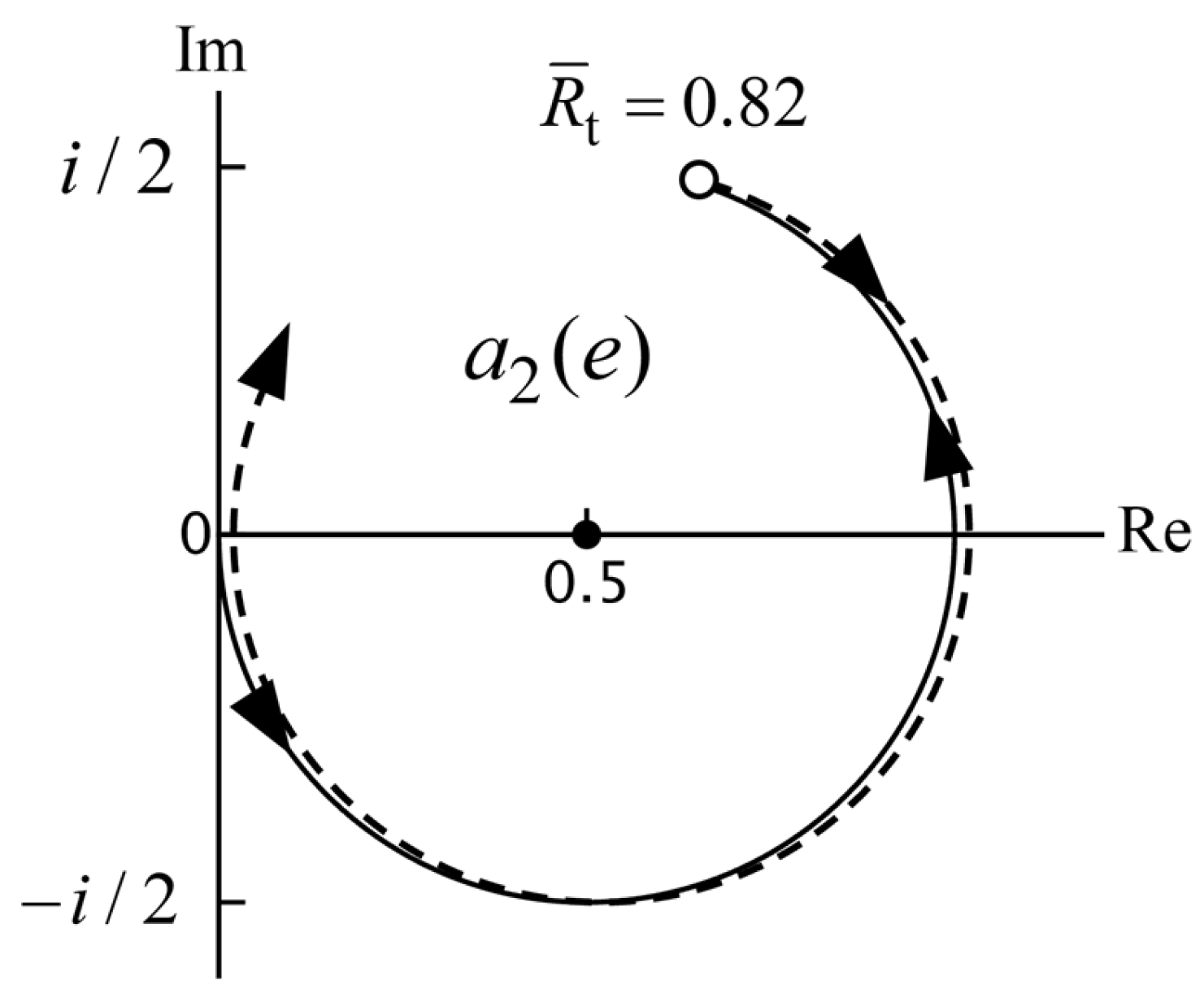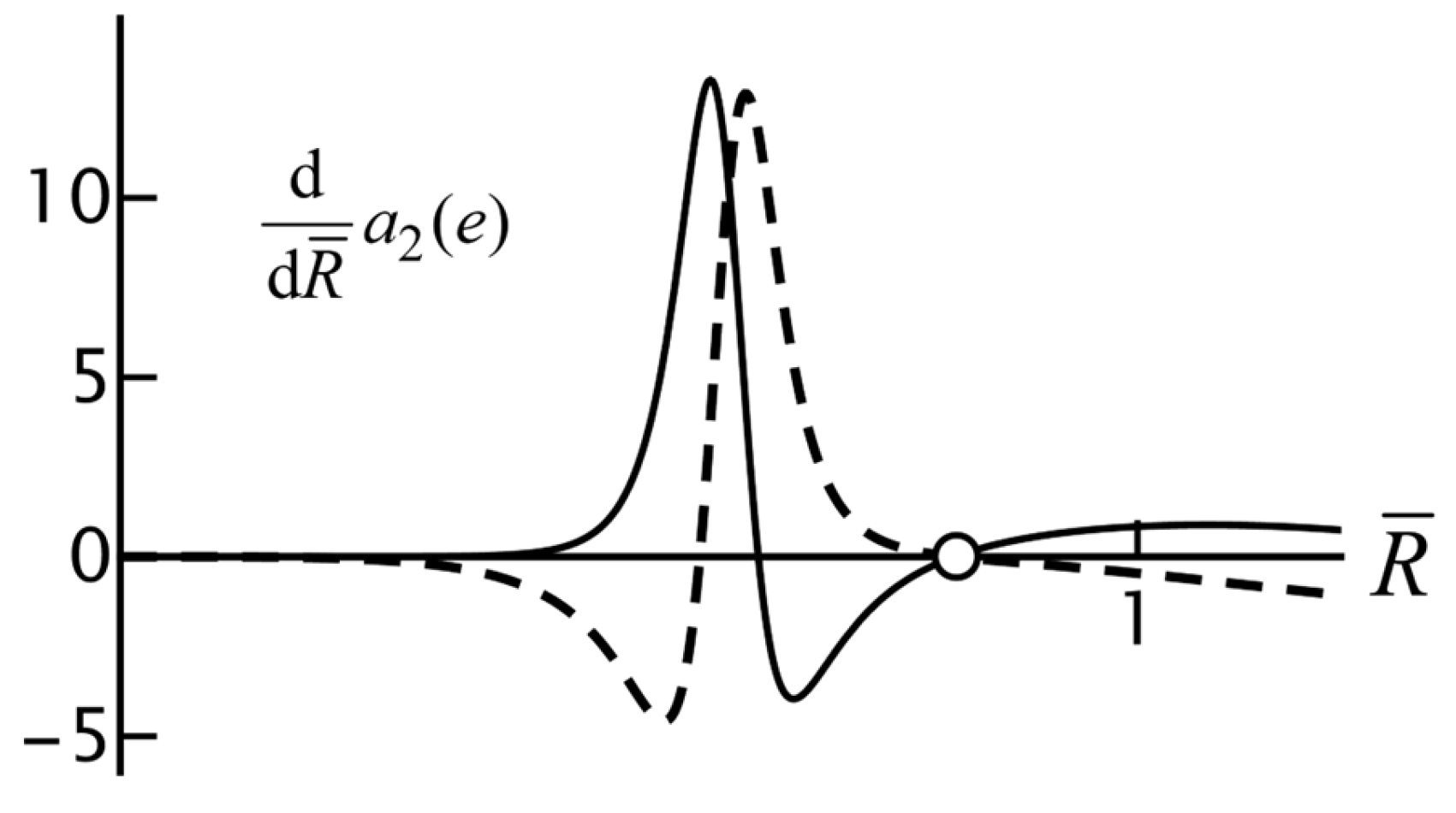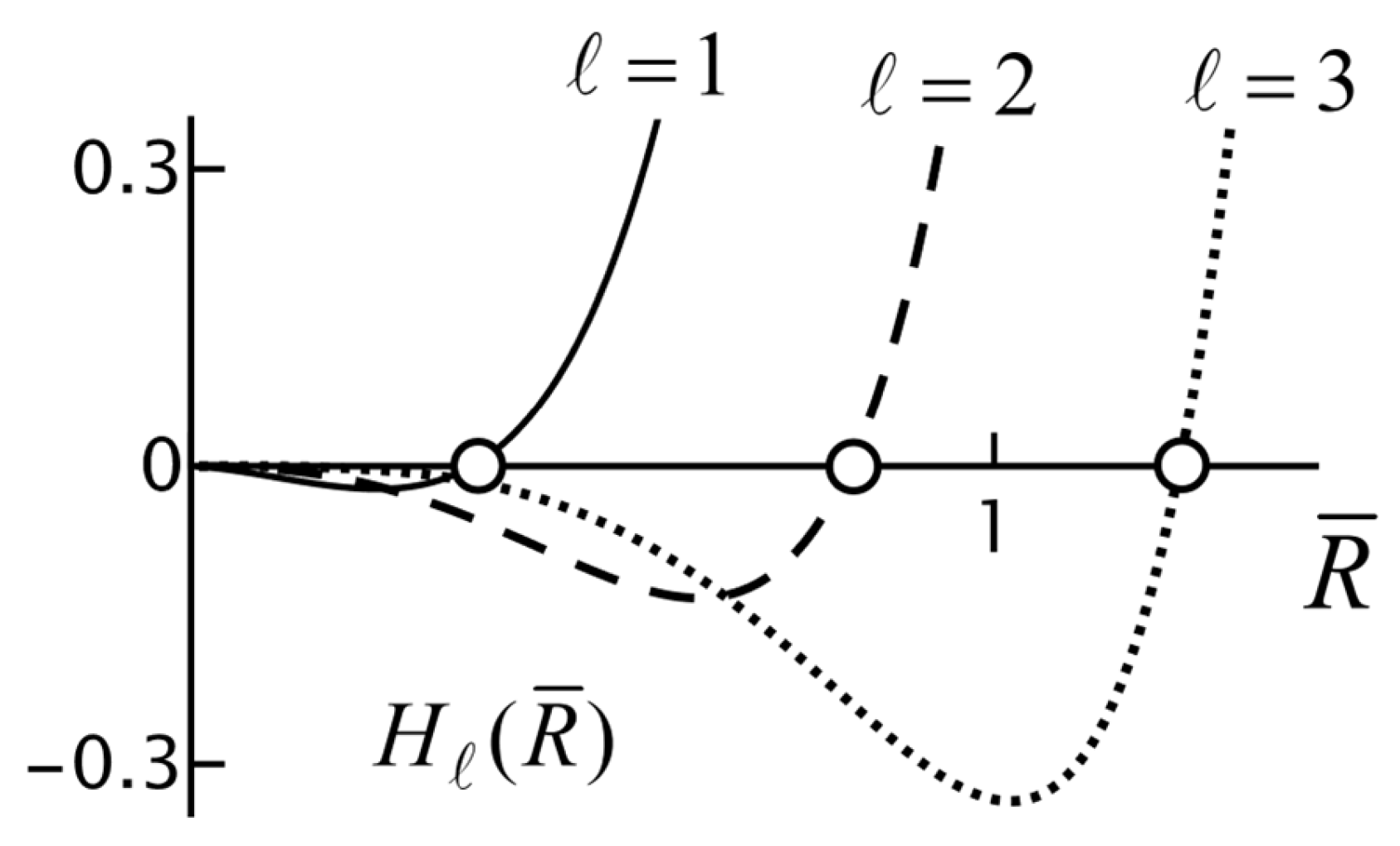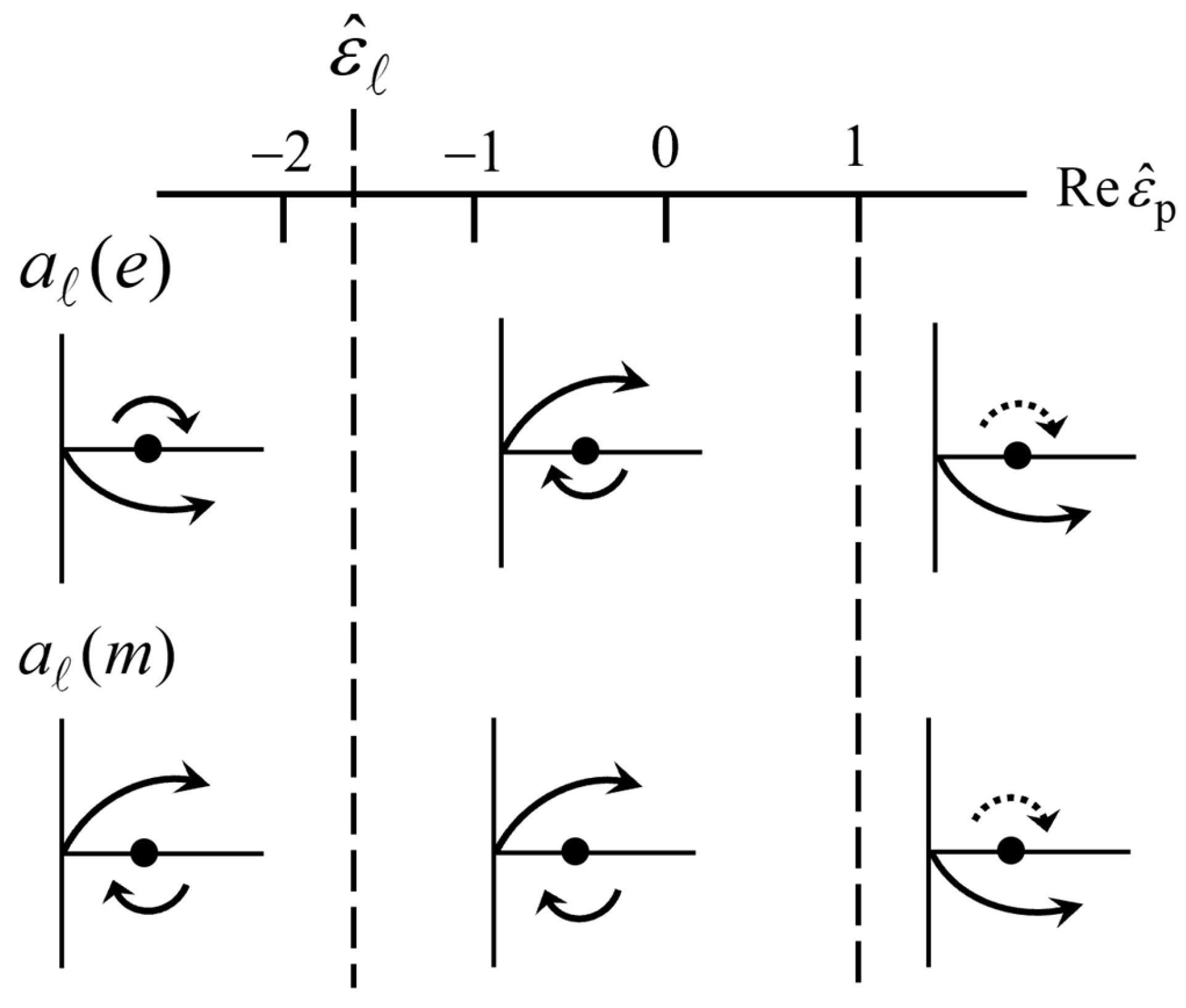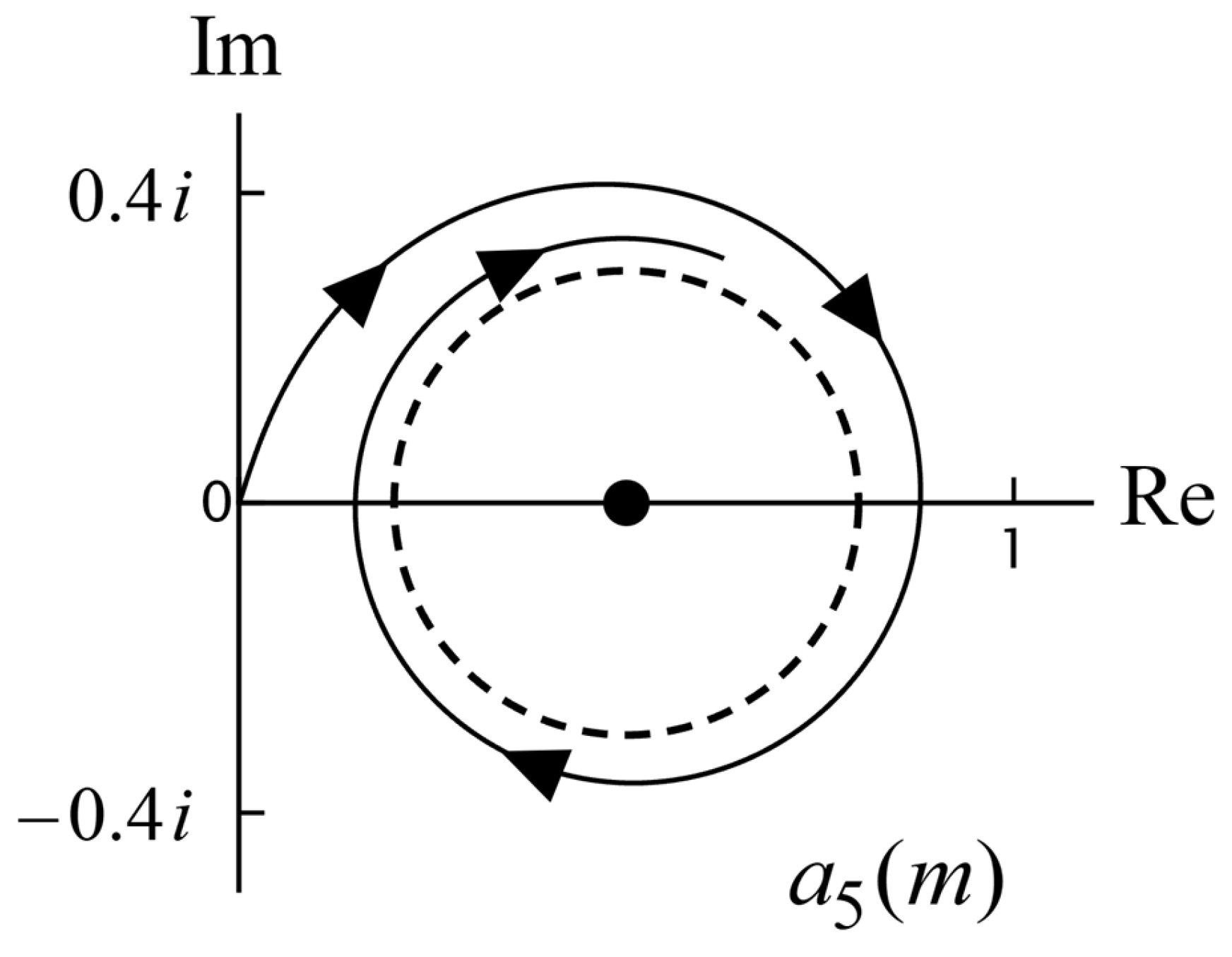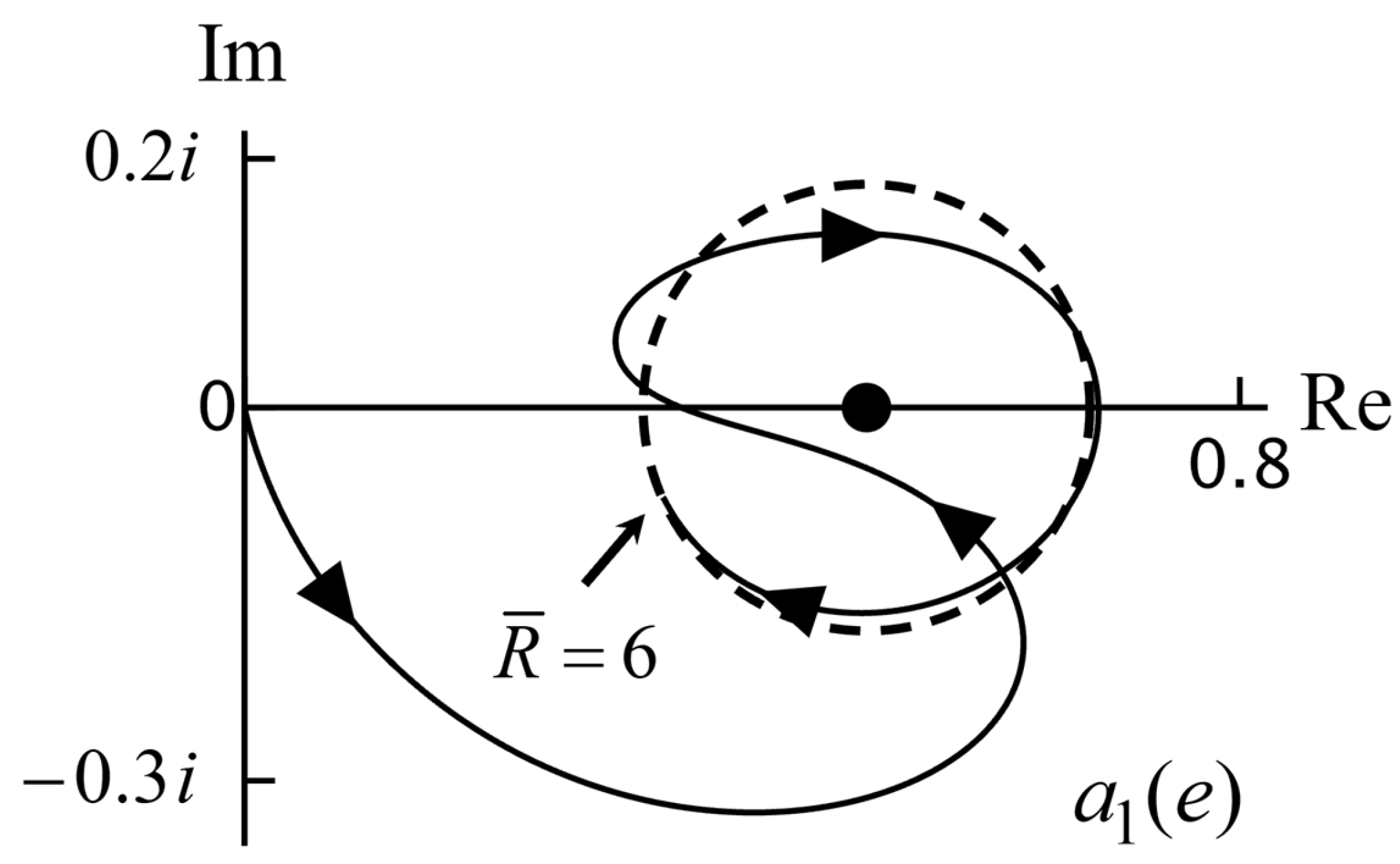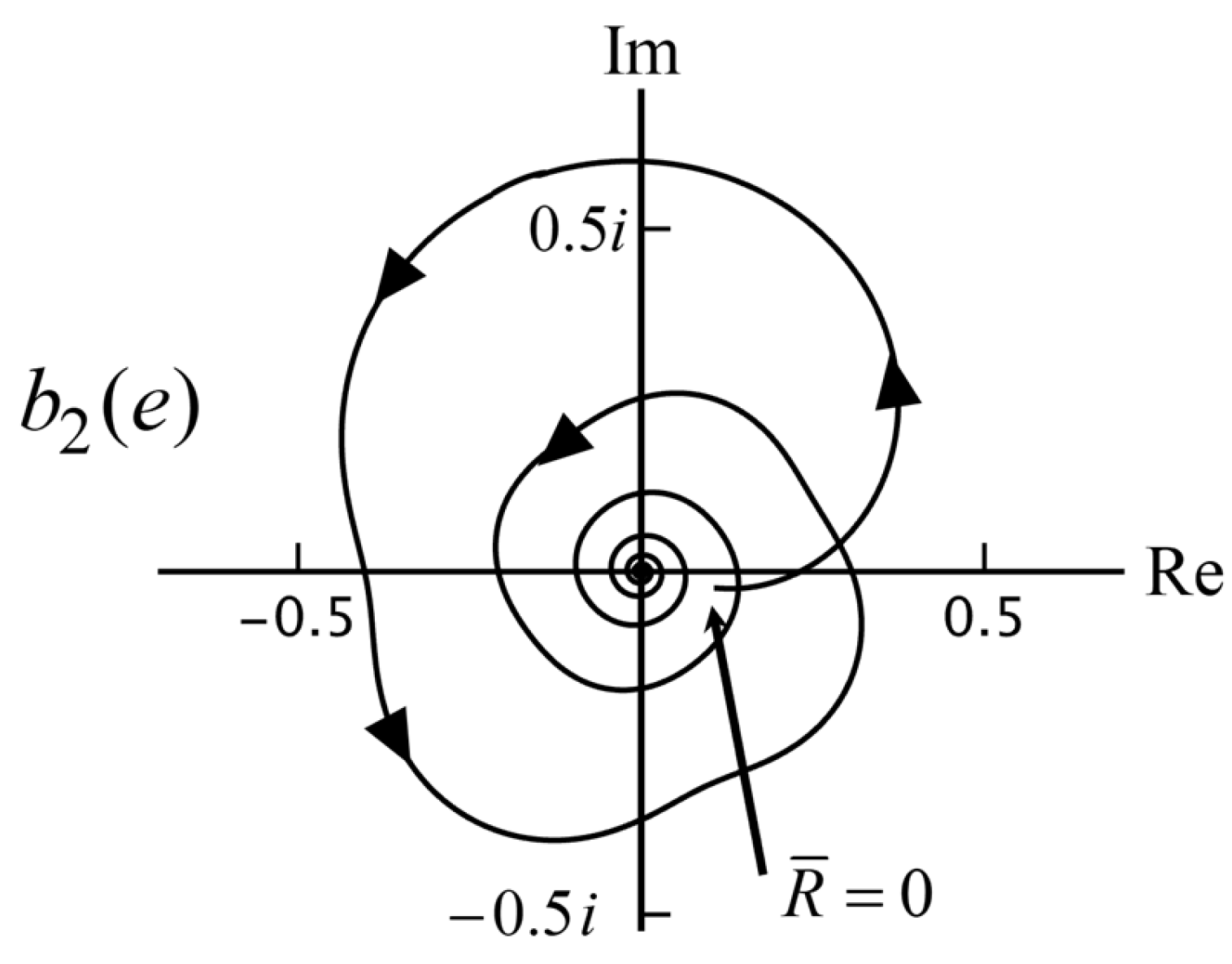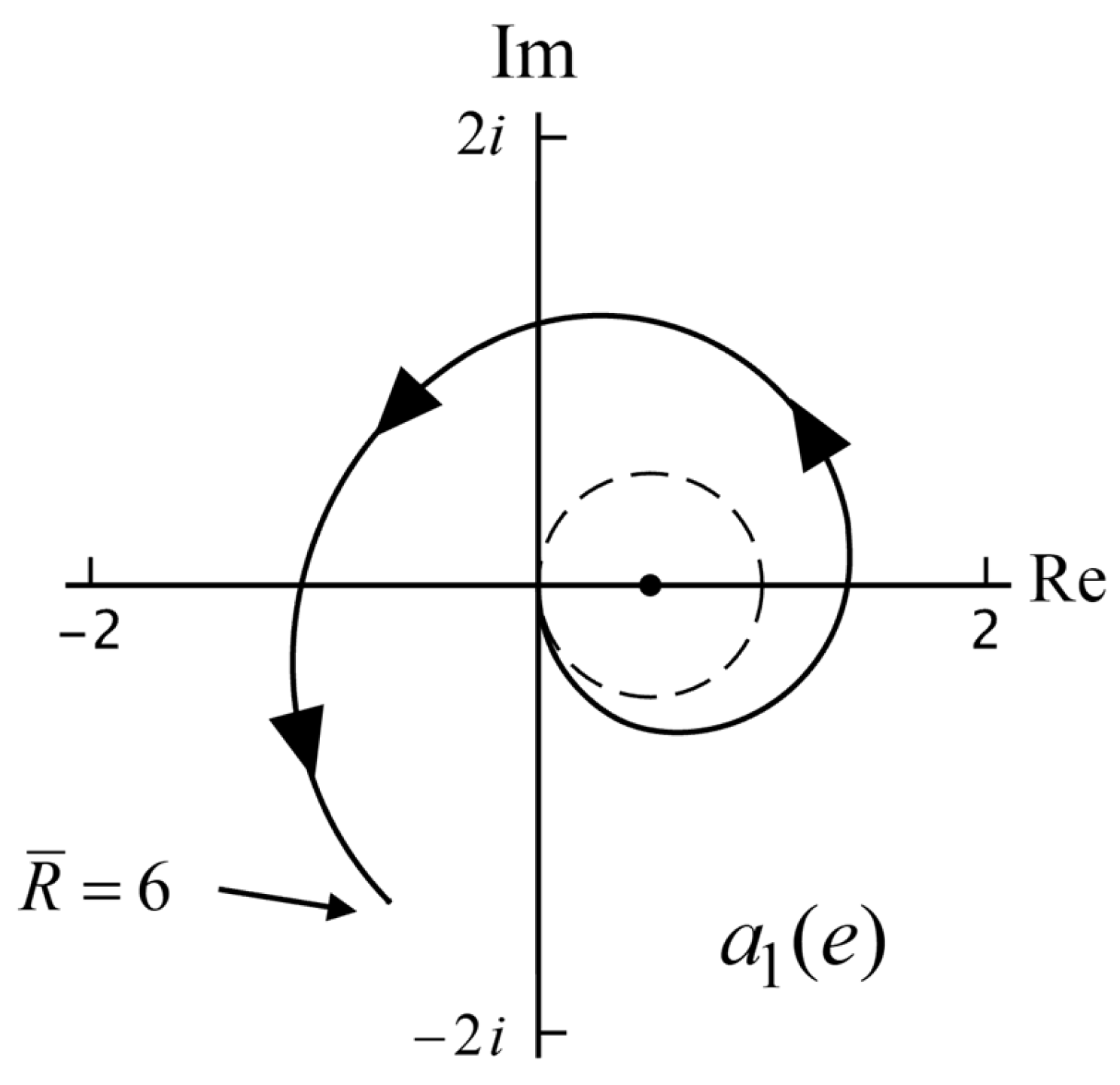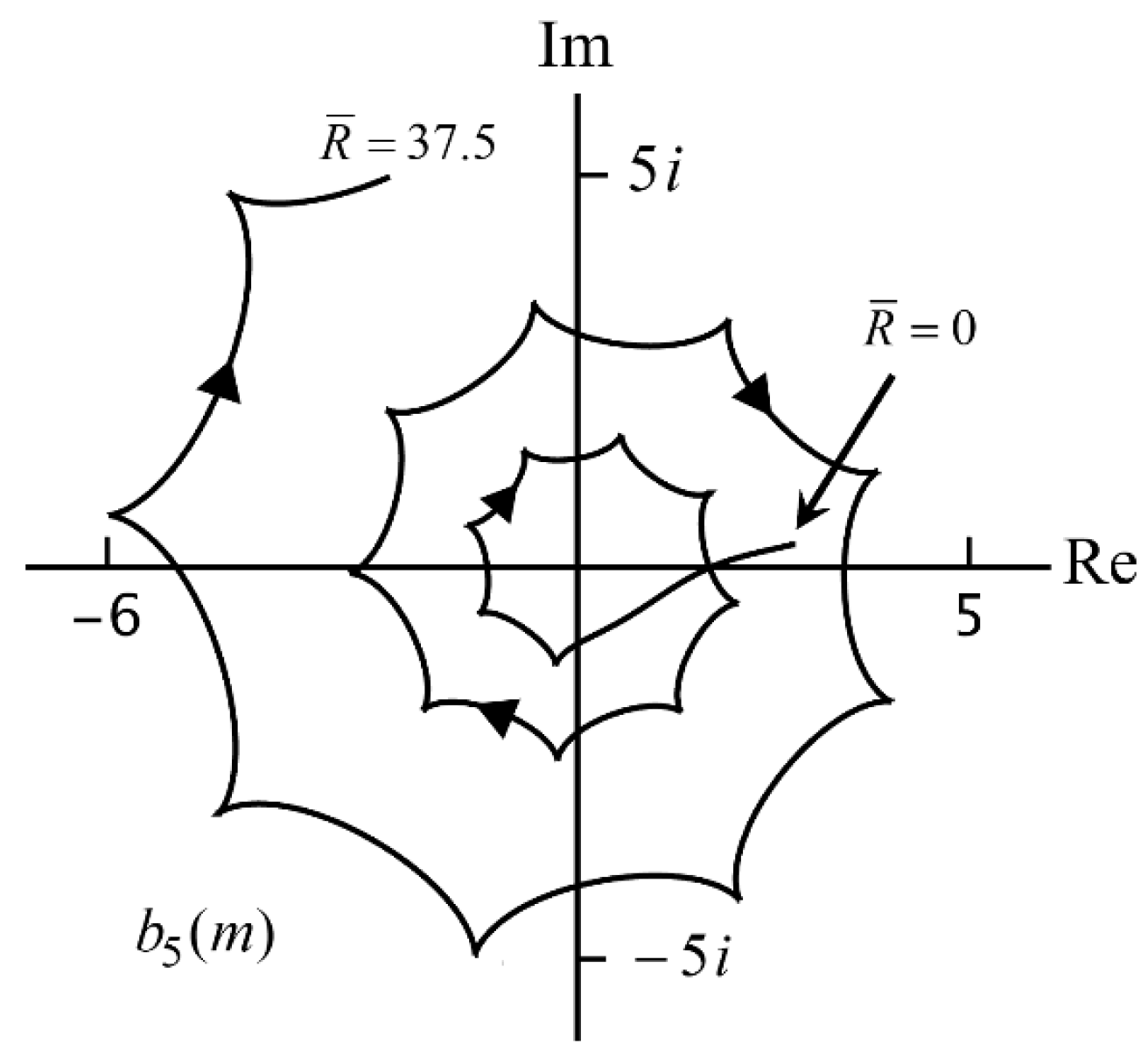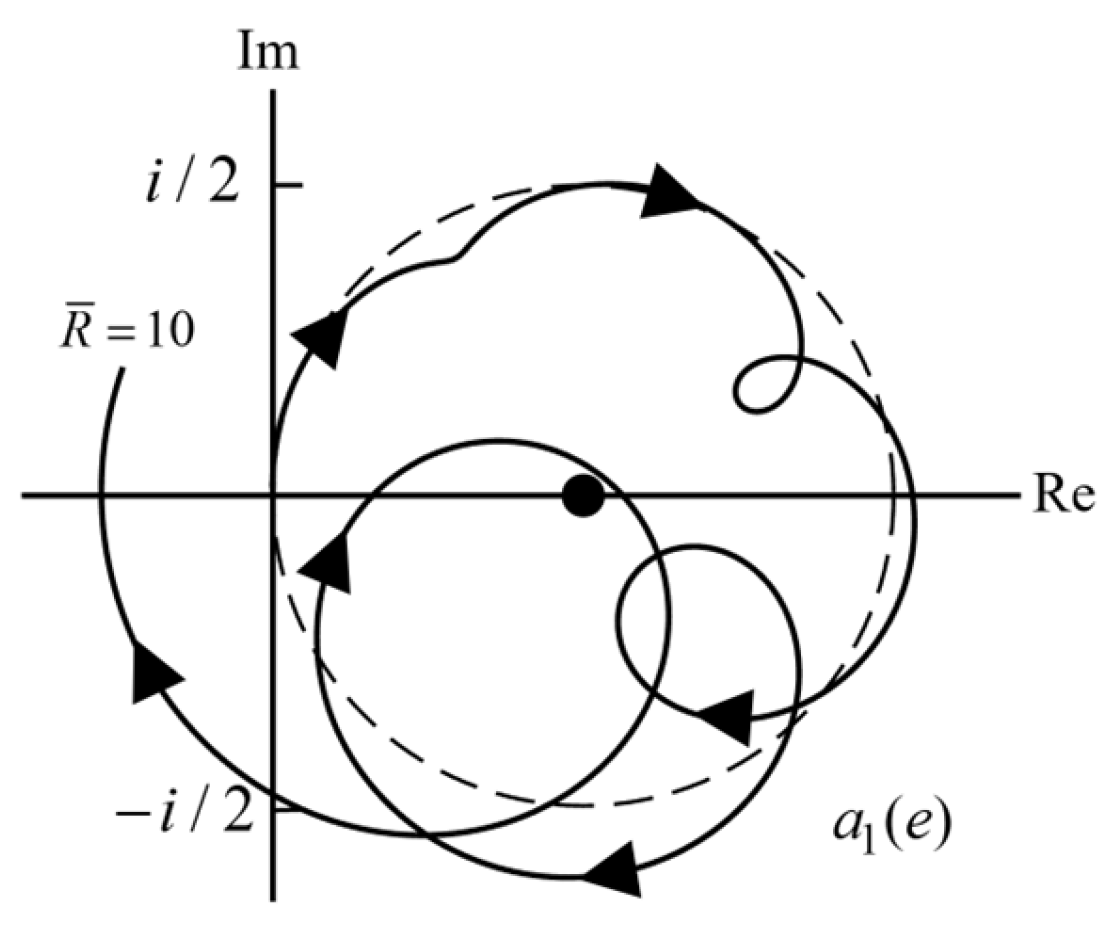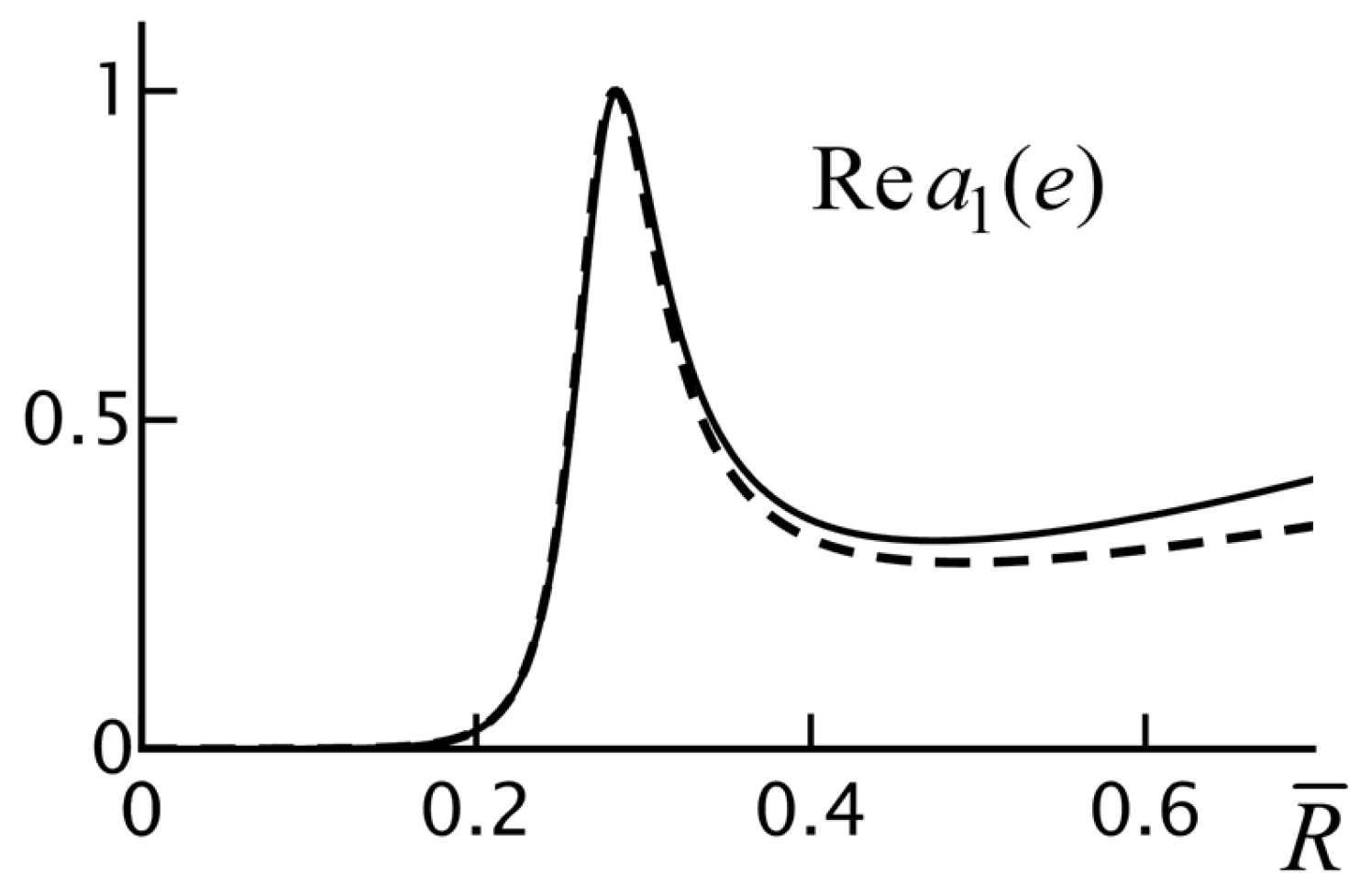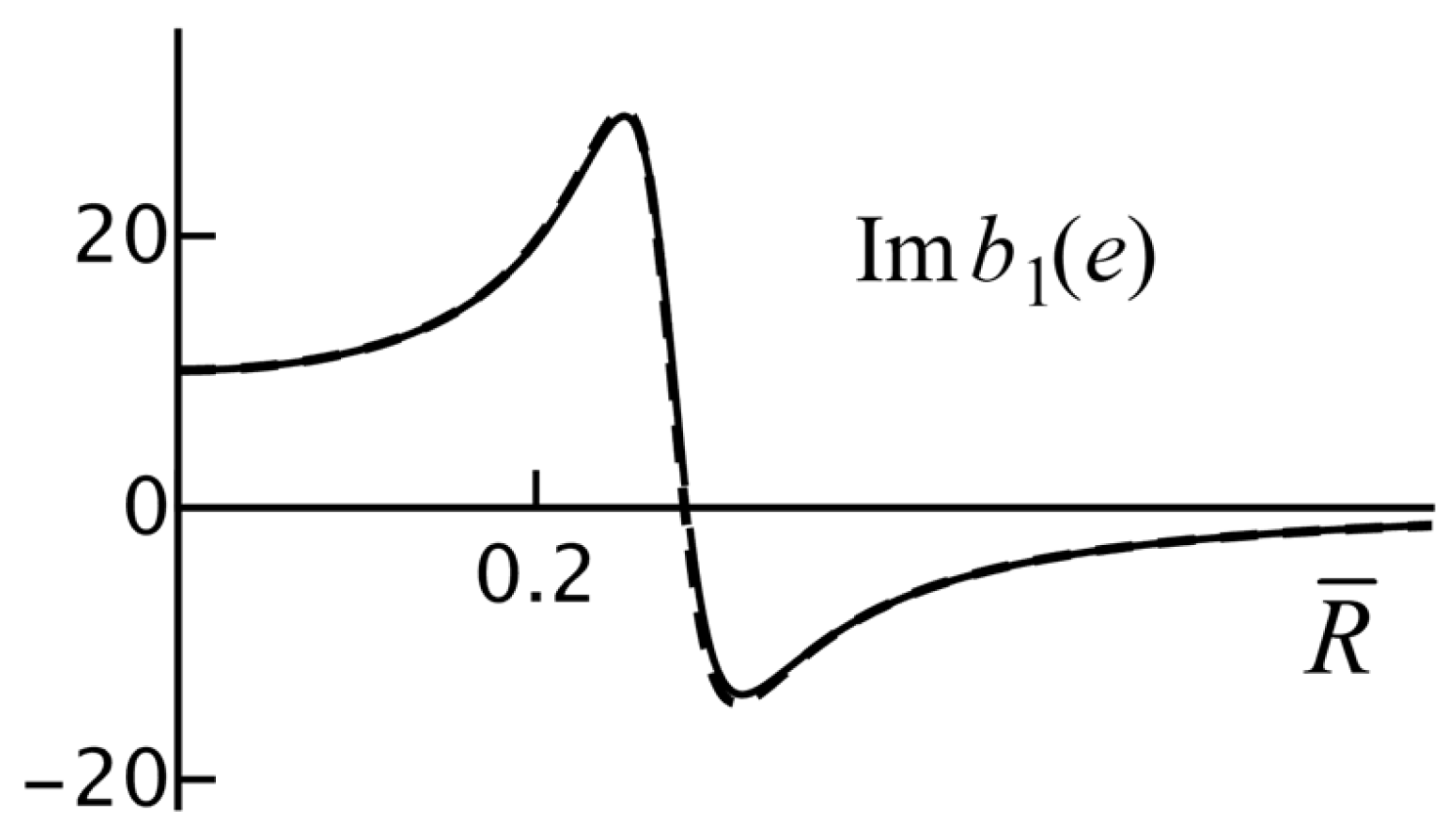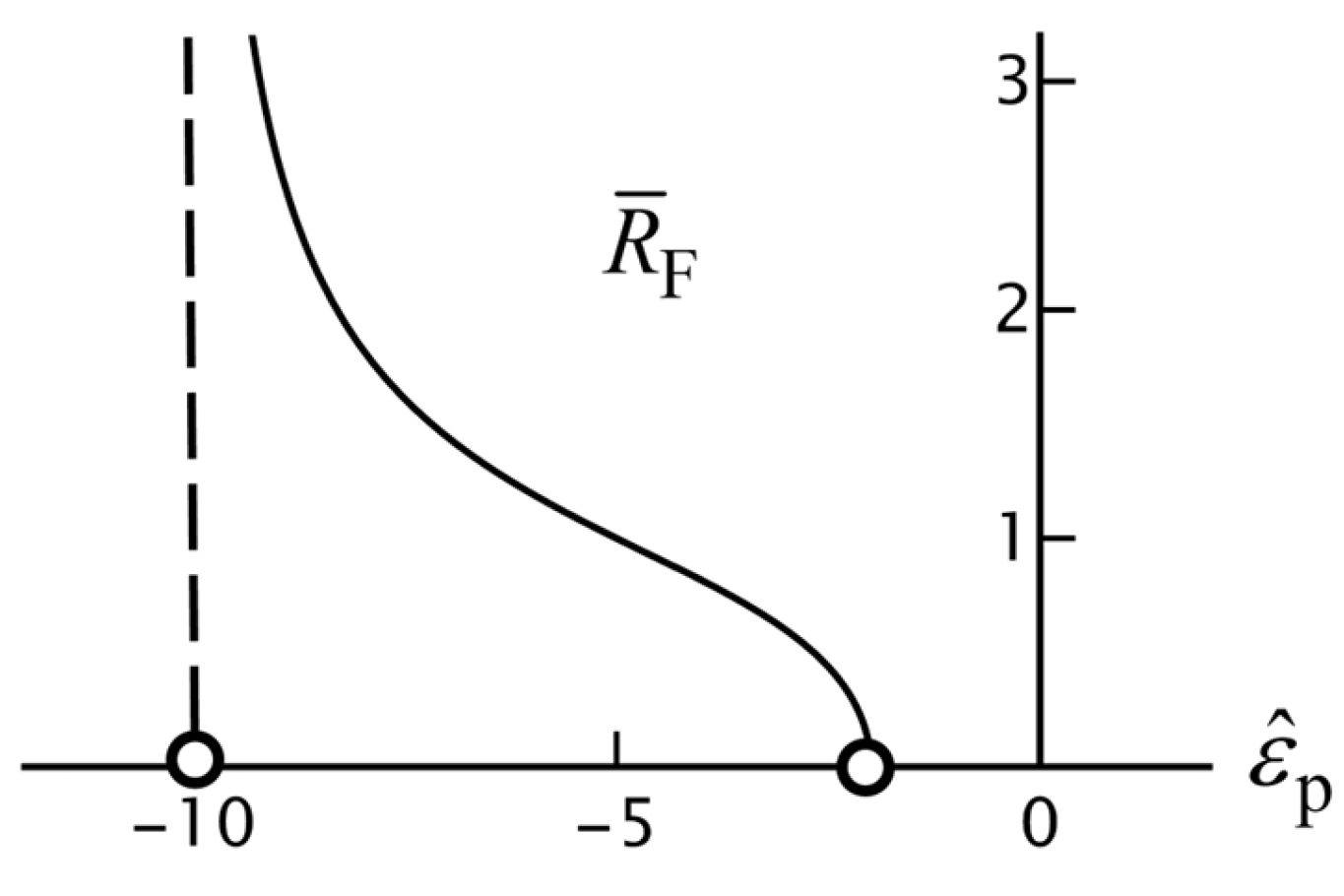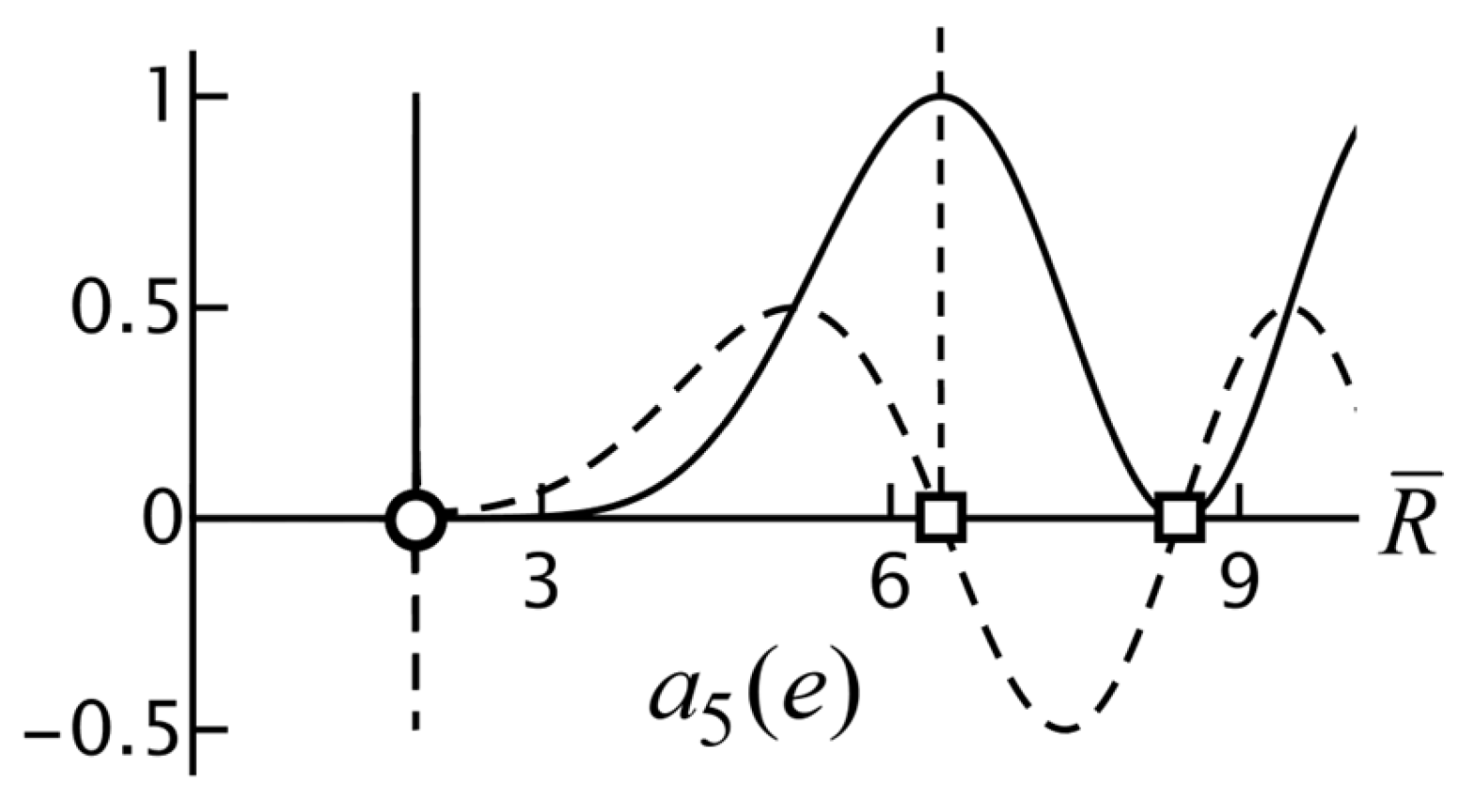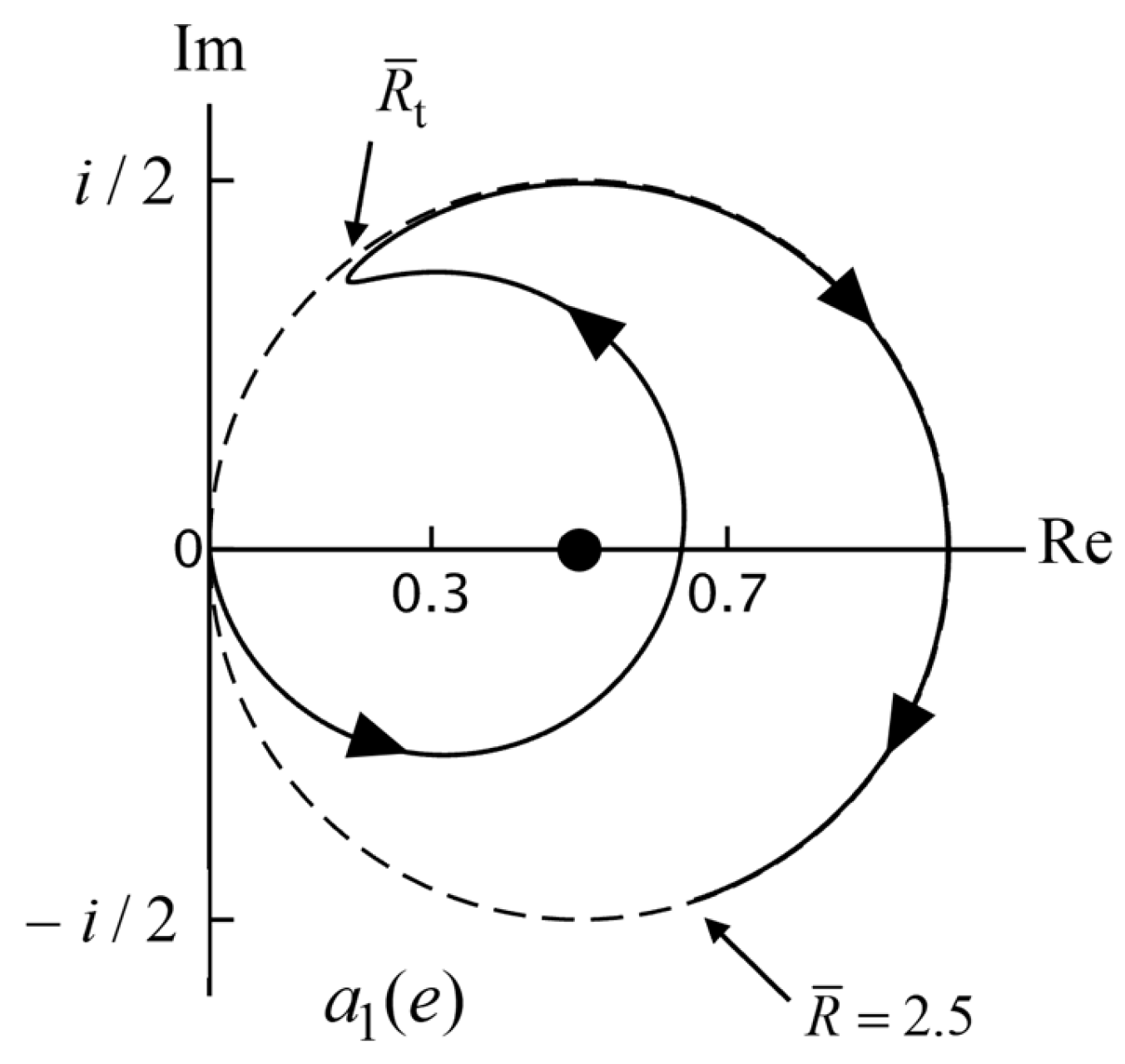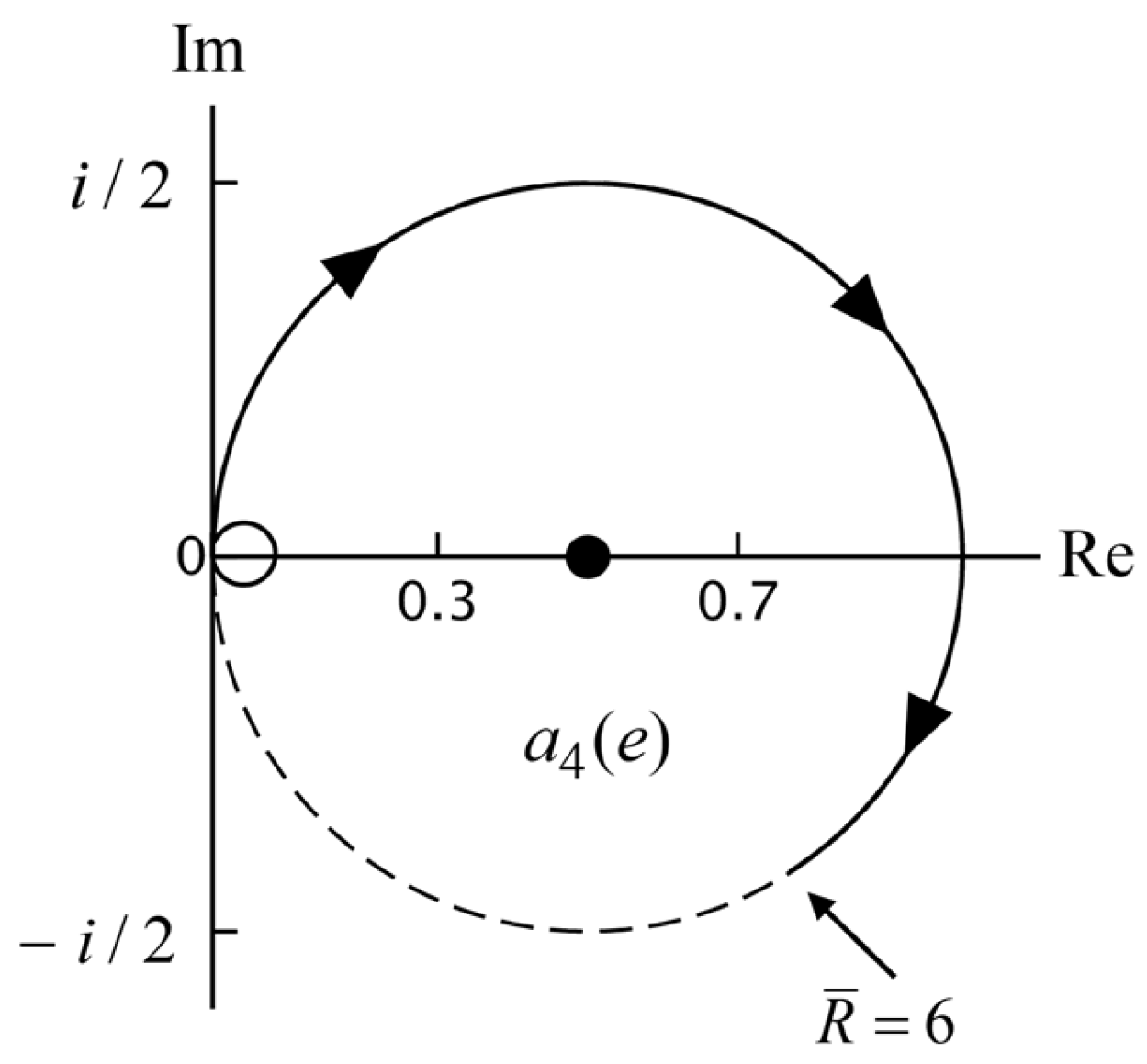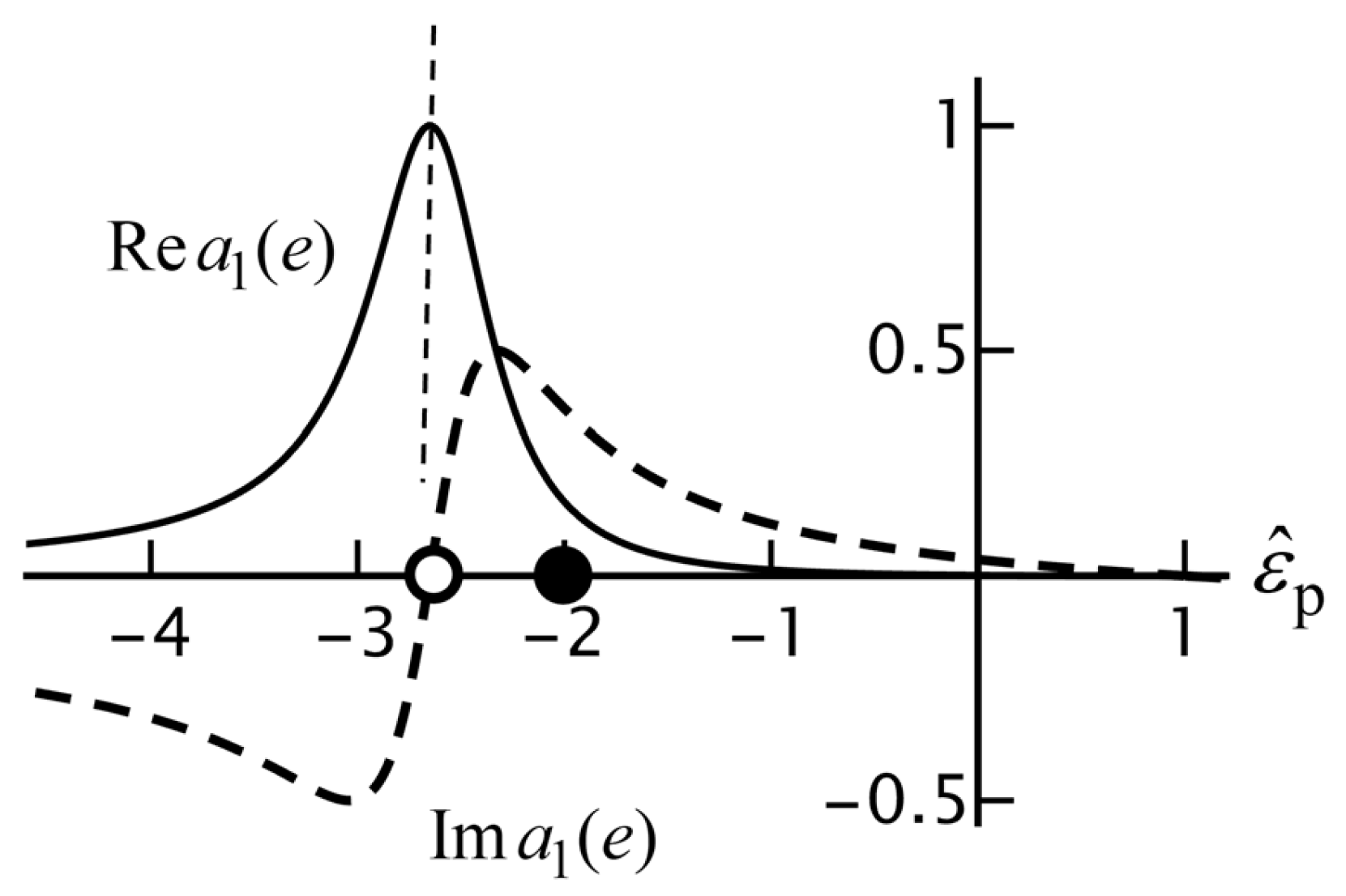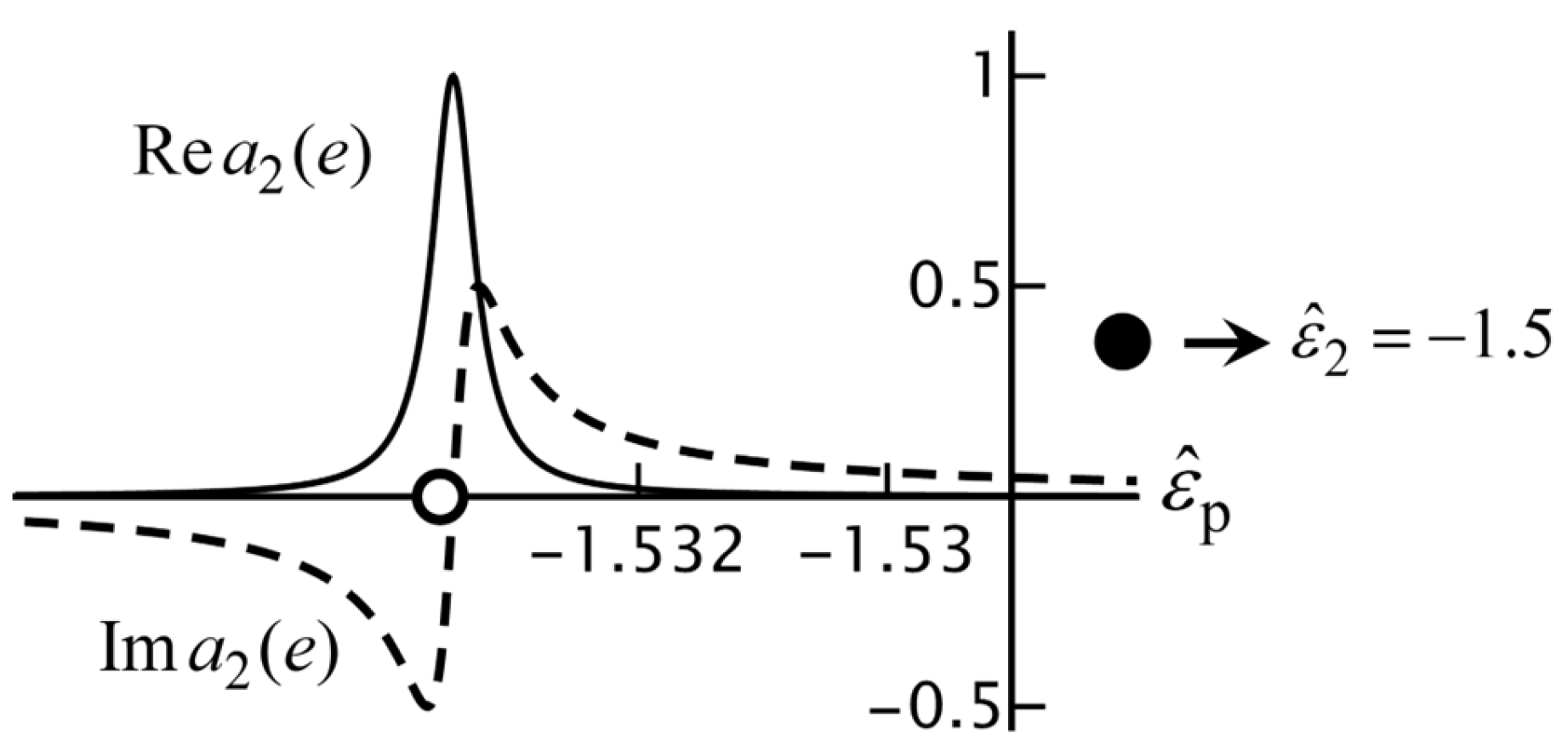2. Incident Field
The incident field is a monochromatic polarized plane wave, with
and
as the complex amplitudes of the electric and magnetic fields, respectively. The electric field itself is
and similarly for the magnetic field. For the electric field, we have
Here,
is the unit polarization vector, normalized as
. This generally complex vector lies in the
plane. The wave vector is
with
as the wave number in the embedding medium. The corresponding magnetic field is
We set
so that
This notation is particularly useful when studying electric and magnetic dipole radiation, as in
Appendix C.
The index of refraction
will be complex, in general. We set
With
the time-dependent electric field from Equation (5) becomes
Due to the overall exponential, the field decays in amplitude into the positive
direction if
. The exponential factor inside
is a traveling plane wave with phase velocity
For
, the wave pattern moves into the positive
direction, and for
, it moves into the negative
direction. It can be shown that the energy always flows into the positive
direction.
In order to eliminate non-essential constants, we introduce dimensionless fields as
For the magnetic field, we take
as
for a field outside the particle and as
for a field inside the particle. For the incident fields, this becomes
For Mie scattering, it is advantageous to consider circularly polarized incident radiation. We take
as a spherical unit vector:
For
, this gives a left-polarized plane wave, or a wave with positive helicity. The electric and magnetic field vectors rotate counterclockwise when viewed down the positive
axis, with the magnetic field lagging the electric field by
For the magnetic field, we have
so, the dimensionless incident fields are related as
For other polarizations of the incident field, the solution can be obtained by superposition.
3. Fields and Mie Coefficients
Mie theory provides the exact solution of Maxwell’s equations for the setup depicted in
Figure 1. Since Mie’s paper, mathematics has evolved substantially, and the theory has been put on a more solid, and elegant, footing. Now, the fields are expanded onto a complete set of vector functions on the unit sphere, the vector spherical harmonics [
22,
23]. Each vector spherical harmonic is multiplied by a spherical Bessel function, and this gives a partial wave of the solution. This gives a consistent expansion of the fields in vector multipole fields.
The scattered fields are
and
and the particle fields are
and
Their explicit expressions in terms of multipole fields are given in
Appendix A. We have electric (
e) and magnetic (
m) multipole fields, and the order of a multipole is indicated by
The amplitudes of the scattered multipole fields are
with
and the amplitudes of the particle multipole fields are
These are the Mie coefficients. It is outlined in
Appendix B how these amplitudes are computed from the boundary conditions at the surface of the sphere. In most references, these Mie coefficients are expressed in terms of Riccati–Bessel functions and their derivatives. Although such representations are very compact, they are not very suitable for analysis.
Appendix B gives various representations of the Mie coefficients. The Mie scattering coefficients take the form
and for the Mie particle coefficients, we have
Here,
Equations (A34) and (A35) give the most useful representations for the auxiliary functions
and
They only involve the spherical Bessel functions
and the spherical Neumann functions
The function
can then be found from Equation (23). Alternatively, Equation (A36) can be used for
which involves the spherical Hankel functions
These are the functions for electric multipoles. They contain the parameter
As explained in
Appendix B, the corresponding magnetic multipole functions simply follow by replacing
by
This implies that any computation performed (as below) for electric multipoles automatically carries over to magnetic multipoles. Oddly enough, this is never recognized in the literature, to the best of our knowledge. The reason is probably that most authors set
. This is a very good approximation for most materials, but it destroys the symmetry between electric and magnetic Mie coefficients. As a result, two sets of equations are presented, one for electric multipoles and one for magnetic multipoles, and all calculations need to be performed twice. Our approach is clearly much more efficient, and elegant.
A Mie resonance is defined as a situation where . It follows from Equation (21) that is a sufficient condition.
The lowest-order multipoles have
representing electric and magnetic dipole radiation. By far the most studied radiation is electric dipole radiation, both in classical electromagnetism and quantum optics. It is shown in
Appendix C that these
multipole fields are identical to the textbook expressions for such radiation, as well as how the dipole moments of the particle can be obtained from the Mie scattering coefficients. For dipoles, the Mie coefficients can be expressed in terms of elementary functions rather than spherical Bessel functions. The explicit results for the dipole Mie coefficients are given in
Appendix D.
Of particular interest is the ever-popular perfect conductor. Such material is impenetrable for electromagnetic radiation, and this gives huge simplifications for all types of problems. A perfectly conducting particle is a metallic particle in the limit where the conductivity becomes very large. In
Appendix E, we derive the expressions for the Mie coefficients for a perfectly conducting particle.
8. Rotation Directions
When there is no dissipation in the medium or particle, then
lies on the Mie circle. For
, we have
and with increasing
, the particle moves around the Mie circle. We shall now consider this in more detail. In order to simplify the discussion somewhat, we shall assume
For
positive, this corresponds to a dielectric particle, as in
Section 4, and for
negative, this is a metallic particle, as in
Section 5.
For
small,
is given by Equation (47). We recall that
from Equation (46) lies in the range
. If
is smaller than
then
is smaller than unity, and the overall factor
is positive. This means that
is negative imaginary, so the rotation around the Mie circle starts counterclockwise. For
, we also have
and again
and so the rotation is initially counterclockwise. For the region in between, e.g.,
, we have
so
is positive imaginary, and the rotation is clockwise. For
, we need to consider Equation (49). For
is negative imaginary, and the rotation starts counterclockwise. For
this becomes clockwise. This is made much clearer by looking at
Figure 6.
For large , we need to consider Equation (56) for . Then, we also have . With the factor rotates around the unit circle in the clockwise direction with increasing The period for this rotation follows from The first factor in square brackets in Equation (56) is periodic with given by Due to the factors and this factor rotates over an ellipse, and it goes counterclockwise. The factor in square brackets in the denominator also gives a counterclockwise rotation with The two factors combined then give a counterclockwise rotation with The period for the rotation of around the unit circle then becomes We conclude that for , the rotation is counterclockwise, and for , the rotation is clockwise. Since we consider in this section, this is equivalent to and respectively, (and in this paragraph). For large and , we have a metallic particle, and the result for large is given by Equation (60). The only rotation is due to the factor and this rotates clockwise.
For with we have Equation (49) for small. The rotation direction only depends on so we have counterclockwise for and clockwise for . For large, there is no difference in the rotation direction between and given
The Mie particle coefficients for small are given by Equation (48), and with , we find the expression for These functions are finite for . For positive, we have positive, and so lies on the positive real axis. For negative, we have and so is proportional to Therefore, lies on the real or imaginary axis, either at the positive or negative side, and when we increase the value of by unity, the picture rotates clockwise over The Mie particle coefficients do not have a specific rotation direction for small.
For
large, we consider Equation (57), when
. With the same arguments as above for
we now find that
rotates clockwise for
and counterclockwise for
. However, the rotation is around the origin and not around the Mie circle, and the path is not circular. An example is shown in
Figure 3. For
we look at Equation (61). The only rotation comes from
and this gives a clockwise rotation. For large
, we have
due to the factor
An example is show in
Figure 5. The three possibilities are illustrated in
Figure 7.
For a perfect conductor, the rotation directions of
are the same as those in
Figure 6 for
9. Turning Points
The rotation directions of the Mie scattering coefficients
around the Mie circle are depicted in
Figure 6. We see that the initial rotation directions (
) and the final rotation directions (
) are the same, except for
when
In this case, the rotation starts counterclockwise and ends clockwise. Therefore, the curve has a turning point
at which the rotation direction reverses. We shall now examine this in detail.
Figure 8 shows an example. At a turning point, it has to hold that
The derivatives of the Mie scattering coefficients with respect to
are derived in
Appendix F. In this section, we shall assume
and we have
for a turning point to occur. Since
is complex, Equation (65) has to hold for the real and imaginary parts of
simultaneously.
Figure 9 shows the real and imaginary parts of the derivative of
for the same parameters as in
Figure 8. We see that near
both the real and imaginary parts of
are zero, so this is the turning point
Near a turning point,
is neither small nor large, so we need to consider the exact solution for all
From Equation (A93), we see that for
the derivative of
is zero. Under this condition, the real and imaginary parts are simultaneously zero. Here, we have
with
so the arguments of
and
are positive imaginary. Then, it is advantageous to switch to modified Bessel functions, as in Equation (32). Equation (66) becomes
Here, we have set
which is positive. Setting
simplifies the appearance of Equation (67) to
Both sides of the equation are squares. With recursion relations for modified Bessel functions, it can be shown that
With the known series expansions of the modified Bessel functions, we find easily that
and its derivative are positive for
. Therefore, the right-hand side of Equation (70) is positive. Then, the expression in square brackets on the left-hand side of Equation (69) is positive, as is
on the right-hand side. Consequently, we can take the square roots of both sides as
We now set
A turning point then corresponds to a solution of
For a solution
the turning point is
Figure 10 shows the function
seen as a function of
for
1, 2 and 3, and for
. The zeros are found from the graph as
and
respectively. Alternatively, Equation (73) can easily be solved numerically, which would give more precise values for
Equation (73) can be written as
and the parameter
is
For
very negative, this parameter becomes large. Then,
is large, and we can consider the modified Bessel functions for the large argument:
The right-hand side is independent of
, so Equation (75) becomes
and this is
For
large, and with
the first
on the right-hand side of Equation (79) can be neglected. At a turning point, we have
so the turning point is approximately
for
large. For the examples in
Figure 10, this gives 0.71, 1.22 and 1.73 for
and
respectively. We have verified that the accuracy of this approximation improves considerably with increasing
For
very large, the particle approaches the perfect conductor limit. The derivative of
is given by Equation (A95). At a turning point, this should be zero, which gives
and this is
Clearly, the approximate value from Equation (81) becomes the exact solution for a perfect conductor.
10. Dissipation in the Particle
When there is no absorption in the particle or the embedding medium, the Mie scattering coefficients lie on the Mie circle, and they rotate around this circle with increasing We shall now consider the effect of damping in the particle. We set so that there is no absorption in the surrounding medium. For the particle material, we shall assume and possibly .
The coefficients
are zero for
. For small
the value of
is given by Equation (47), and with
, this gives
provided that
. For
we need to consider Equation (49). Without absorption,
is pure imaginary, so with increasing
the rotation starts either up or down the imaginary axis. This is expected, because the imaginary axis is the tangent line at the Mie circle at
. With absorption,
has a real part, and so the initial direction with increasing
is under an angle with the imaginary axis. Equation (47) reads
For
real, the shown factor is imaginary. For
complex, we set
Under the assumption that the damping is relatively small, we then find
with
which is positive. Therefore,
and the curve in the complex plane bends away from the imaginary axis to the right. From a different point of view,
moves to the inside of the Mie circle. The initial direction along the imaginary axis is the same as without absorption, provided we replace
by its real part. For
, we assume
and it then follows immediately from Equation (49) that the same conclusion holds.
For large
the general expression is given by Equation (56). We shall now simplify this result for the case that there is damping in the particle. The particle index of refraction
is complex, and we write
For the sines and cosines in Equation (56), we use
. This yields
Both terms grow exponentially with
due to the factors
Fortunately, these factors appear both in the numerator and denominator, so they cancel. We obtain
for
large. For magnetic multipoles, we replace
by
and we use the identity
This gives
which differs from
by only a minus sign.
The only rotation in
comes from
which is clockwise, and the path in the complex plane is a circle around the origin. Then,
rotates clockwise around the point 1/2, and the radius of the circle is
This circle is concentric with the Mie circle, and we shall call this the
reduced Mie circle. The radius
is the same for electric and magnetic multipole coefficients. Also interesting to see is that the rotation direction for
large is the same for all parameters. This is in contrast to the case without damping, where the rotation is counterclockwise for
(
Figure 6). We note that the reduced Mie circle does not necessarily go over in the Mie circle in the limit of no damping. We have used
to arrive at Equations (88) and (89), and this excludes the limit
.
Figure 11 summarizes the rotation directions for the case when there is damping in the particle. The initial rotation direction is determined by the real part of
and the curves start under an angle with the imaginary axis such that the damping gives a deviation to the right. For
, we assumed
. The final directions for all cases are clockwise, so this is independent of
As compared to
Figure 6, we see that for
the rotation direction is opposite to the case without damping, so the dissipation in the particle reverses the final rotation direction. Since this direction is opposite to the initial rotation direction, the Mie coefficients must have a turning point due to the absorption of energy in the particle.
Figure 12 shows a typical curve in the complex plane. The rotation direction is clockwise for all
and for
large, the curve approaches the reduced Mie circle. Another example is shown in
Figure 13. The initial rotation is counterclockwise, but then the direction reverses and becomes clockwise by the time it reaches the reduced Mie circle. A similar case is shown in
Figure 14, but now we can clearly see the predicted turning point. Without absorption, the rotation direction would be counterclockwise for all
The Mie particle coefficient
at
is given by Equation (48), and the value of
at
follows from
They are finite, but they do not lie on an axis as they do without damping. With a similar calculation as above, we find for
large
and for
, we replace
with
For large
due to the factor
The Mie coefficients spiral into the origin, unlike without damping, where this only happens for
(
Figure 7). The rotation around the origin comes from
The rotation is counterclockwise for
and clockwise for
A typical example is shown in
Figure 15.
12. The Fröhlich Mode
It was shown in
Section 6, Equation (47), that for
small we have
with
We notice immediately that there is a problem if
is close to
and since
is negative, this can happen easily for a metallic particle. This situation is referred to as the Fröhlich resonance, or the Fröhlich mode. The Mie particle coefficient
from Equation (48) has the same problem. A division by zero would give an infinite Mie coefficient, which is unphysical. Moreover, we know that without damping,
lies on the Mie circle. The magnetic multipole Mie coefficients do not have this issue (unless one would consider
which is unrealistic), so in this section, we shall only consider electric multipoles. It is often argued in the literature that one should include a small positive imaginary part in
in order to keep
finite. We shall show below that this gives the wrong result [
26]. This issue was also addressed in [
27], from a different point of view.
The small-
limit of the Mie coefficients was derived in
Section 4, starting from the representations (21) and (22). We expanded the functions
and
in a Taylor series in
with the results given by Equations (43) and (45). In the numerators, we have
Since
is of a much higher order in
we neglected
in
and this gave the results shown in Equations (47) and (48). From Equation (45) we see that
is zero at
and this is the root of the problem with the approximation (97), and similarly for
. When
we need to retain
in
First, we change to alternative
and
which are more suitable for the study of
small. The Mie coefficients are then
with
From here on, we shall use an equal sign instead of
for the small-
approximation. For
, we keep the result from Equation (43):
but for
, we add one more term in the Taylor expansion for small
This gives
Here, we introduced the parameter
The new and improved small-
approximations to the Mie coefficients are then given by Equations (100) and (101).
First, we notice that the singularities for near have disappeared. Second, without damping in the particle or the surrounding medium, and are real. So, has the same form as in Equation (25), and therefore the approximation lies on the Mie circle. This reflects conservation of energy, even for the approximate formula. Third, for we have and so this resonance is a Mie resonance in the true sense of the meaning. As a consistency check, consider a transparent particle. Then, and we immediately find , and so . From Equation (104), we see that and with , we find .
Figure 19 shows
as a function of
and the small-
approximation. We have
which is close to
for
.
Figure 20 shows
for the same parameters. We notice that the approximation is excellent. Another thing to see is that the exact curve indeed gives a resonance, where
(and
not shown in the graph). It can also be verified that for parameters not near the Fröhlich resonance, the new approximation for
small is a huge improvement, as compared to Equation (97).
For the remainder of this section, we shall set
μ1 = 1,
. Then,
from Equation (104) simplifies to
with
With Equation (46) we have
Since
we have
and we also see that
lies in the range
.
Table 2 shows various values of
and
Function
from Equation (103) is the Fröhlich resonance function. At the resonance, we have
so the resonance condition becomes
Under this condition, we have
. Let us now consider the
dependence of
for a given
in more detail. It follows from Equation (108) that a resonance occurs at the radius
provided that the argument of the square root is positive. We call this the Fröhlich radius. The first condition for
to exist is that
must be real. Then, for
, we must have
and for
, we must have
. With Equation (105) for
we find that
must lie in the range
In principle, there could also be a solution for
but this is too far away from the Fröhlich resonance, and the value of
would be too large to justify the small-
approximation. This also brings up the condition that the predicted value of
by Equation (107) must be small enough for the small-
approximation to hold.
Figure 21 shows the dependence of
on
for
. For larger
values, the curve becomes much steeper, thereby increasing the value of
for a given
The Fröhlich resonance function from Equation (103) can be written as
which shows more clearly that
for
We see from
Figure 19 that
has the appearance of a resonance line. With the above, the width
of the line (half-width at half maximum) can be estimated to be
For the line in
Figure 19, we find
with Equation (107) and
with Equation (112). When measured from the graph, we find
and
. The width of the line decreases very rapidly with increasing
as shown in
Figure 22. With Equations (109) and (112), we find
and
respectively, and from the graph, we measure these quantities as
and
The accuracies of the predicted values with the small-
approximation are
and
respectively. In
Figure 23, we have
and the Fröhlich resonance is extremely narrow. From the graph we find
and with Equation (109) we get
. The discrepancy between the two numbers is due to the fact that
is relatively large, so that the small-
approximation becomes invalid. Nevertheless, the Fröhlich resonance is still there.
The relative width
of the Fröhlich resonance is extremely small. For instance, for the parameters in
Figure 19, we have
Experimentally, it seems impossible to make a particle with such a precise radius. In an experiment, one would scan the laser (angular) frequency
in order to measure the lineshapes. The material parameters
and
depend on
but in a very smooth way. Their variation with
over a small frequency range can be neglected. Moreover,
only enters the expressions for the Mie coefficients through
and this wave number in free space only comes in through the scale factor in
So, we have
When we consider the particle radius
as fixed, then a graph of a Mie coefficient as a function of
is identical to a graph of this coefficient as a function of
apart from the scale factor
on the horizontal axis. Then, a line in the
graph becomes a spectral line in the
graph. The Fröhlich resonance in an
graph appears at
A change
in
then becomes a change
in
with
the spectral width of the line. We then find
so, the relative widths are the same in both representations. If the resonance
exists, then we have
as follows from
Figure 21. Let the particle be a nano-particle with
With Equation (113), we then find
, which is in the visible region of the spectrum. The width of the line is with Equation (114)
or about 10 GHz. So, in order to resolve the line experimentally, the laser linewidth has to be somewhat smaller than 10 GHz. This is easily possible with today’s lasers.
The Frölich resonance in the
dependence occurs when
is real and smaller than
It was shown in
Section 9 that under these conditions,
must have a turning point on the Mie circle. At this point, the derivative of
with respect to
vanishes. For the small-
approximation, we find
This is zero for
provided that the right-hand side is a positive number. This is so under condition (108). A comparison with Equation (109) shows that the turning point is related to the Fröhlich resonance radius as
in the small-
approximation. In
Section 9, we presented a method for finding the turning point without any restrictions on the value of
. As an example, for the turning point of
with
we find from Equation (116) that
whereas the exact solution gives
.
A peculiar phenomenon associated with the Fröhlich mode is shown in
Figure 24. When
is real,
lies on the Mie circle. When
has an imaginary part,
curves inwards, and for large
, it rotates around the reduced Mie circle in a clockwise direction, as shown in
Section 10. For small
the rotation is counterclockwise, so there is a turning point. We now consider the case where the imaginary part of
is relatively small. Then,
is almost positive imaginary, and the radius of the reduced Mie circle is
with Equation (93), so it almost coincides with the Mie circle. We see from the figure that a circle inside the Mie circle appears for
After the turning point, the curve continues along the Mie circle, which is actually the reduced Mie circle. The graph shows the exact
, but the curve for the small-
approximation gives nearly the same graph. This suggests that this circle-in-a-circle has its origin in the Frölich mode. It can also be shown that when
is far away from the Fröhlich mode, the small circle disappears. It either becomes bigger, and then coincides with the Mie circle, or it shrinks to a point.
Figure 25 illustrates the same phenomenon for different parameters.
The central parameter for the Fröhlich mode is the relative permittivity
of the particle. In order for the resonance line to be present,
must be close to
and somewhat smaller than
according to
Figure 18. We shall now consider the Mie coefficients as a function of
for a fixed value of the particle radius
. In the resonance function
from Equation (103), the parameter
depends on
In order to simplify the algebra a little bit, we shall set
in
and we indicate this approximation by
We find from Equation (105)
Table 3 shows some values of
The resonance condition (108) becomes
The solution of this equation is
We could call this the Fröhlich resonance permittivity. The resonance function becomes
which shows that the Fröhlich resonance is located at
Since
we have
Unlike
from Equation (109),
always exists.
Figure 26 shows the exact
for
. The expected peak, according to the old approximation, Equation (97), should be located at
but with the new and improved approximation, it should be located at
So, there is a line shift of
This shift is to a lower
and it is due to the finite radius
of the particle. The shift measured from the graph is
whereas the estimate (122) gives
. The linewidth is estimated to be
The linewidth found from the graph is
whereas Equation (123) predicts
. The estimates for the shift and the width seem reasonably accurate, especially since the radius
of the particle is not really small. The linewidth decreases rapidly with increasing
as is illustrated in
Figure 27. We also see that the original expectation
of the line position is way outside the graph on the right. This is an example of the serious improvement with the new small-
approximation. For the estimated values of the width and the shift, we find that the estimated shift has an error of
whereas the linewidth has an error of
